|
|
|
| My Favourite Planet > English >
People > Ancient Greek artists> Sculptors I-M |
| MFP People |
Ancient Greek artists – page 4 |
 |
Page 4 of 14 |
 |
|
| |
| Sculptors I - M |
| |
| I K
L M |
|
| |
Iktinos
Ικτίνος (Latin, Ictinus)
Architect and sculptor from Athens, Mid 5th century BC
Iktinos and Kallikrates designed the Parthenon in Athens (Plutarch, Parallel lives, Pericles, chapter 13, section 4).
He was the also architect of the Temple of Apollo at Bassai (Pausanias, Description of Greece, Book 8, chapter 41, sections 7-9) and the Telesterion, the temple of Demeter and Persephone at Eleusis (Vitruvius, Book 7, Introduction, section 16).
See Iktinos under architects for further information. |
|
|
| |
Iason the Athenian
(also referred to as Jason)
Ιασων Ἀθηναιος
Working in Athens, early 2nd century AD
Known only from his inscribed signature on a Roman period marble statue of the personification of Homer's Odyssey, found in the Athenian Agora. Agora Museum, Athens. Inv. No. S 2039.
ΙΑCΩΝ
ΑΘΗΝΑ [Ι
ΟCΕΠΟ
ΕΙ
Jason the Athenian made it
See the article and photos in Homer part 1. |
|
|
| |
| Sculptors |
K |
|
 |
|
| |
Kalamis (5th century BC)
Κάλαμις (Latin, Calamis)
A Greek artist named Kalamis was mentioned by a number of ancient authors of the Roman period. Modern scholars believe that these references point to at least two, perhaps three different artists:
Kalamis 1,
a sculptor of the 5th century BC;
Kalamis 2,
a sculptor of the 4th century BC;
Kalamis 3,
an artist working in silver, perhaps Kalamis 2. |
|
For further details, see the Kalamis page. |
|
|
| |
Kallikles
Καλλικλῆς; Latin, Callicles
Mid-late 5th century BC
From Megara (Μέγαρα), central Greece
A contemporary of Pheidias, he was the son of the sculptor Theokosmos of Megara, and perhaps the father of the sculptor Apelleas son of Kallikles. It has been stimated that he may have been working from around 420 BC.
When describing statues of Olympic victors in Olympia, Pausanias, noted the statue by Kallikles of Megara of the men's boxing champion Diagoras (Διαγόρας) of Rhodes, who is thought to have won in the 79th Olympiad (464 BC). We are also told that this Kallikles was the son of the Theokosmos (Θεόκοσμος) who made the statue of Zeus at Megara, mentioned by Pausanias in Book 1 (see Theokosmos of Megara). Given the assumed dates of Kallikles' career, it is thought that the statue may have been made many years after Diagoras' victory.
"When you have looked at these also you will reach the statues of the Rhodian athletes, Diagoras and his family. These were dedicated one after the other in the following order. Acusilaus, who received a crown for boxing in the men's class; Dorieus, the youngest, who won the pancratium at Olympia on three successive occasions. Even before Dorieus, Damagetus beat all those who had entered for the pancratium.
These were brothers, being sons of Diagoras, and by them is set up also a statue of Diagoras himself, who won a victory for boxing in the men's class. The statue of Diagoras was made by the Megarian Callicles, the son of the Theocosmus who made the image of Zeus at Megara."
Pausanias, Description of Greece, Book 6, chapter 7, section 2. At Perseus Digital Library.
Five small white marble fragments of the inscribed base of the statue of Diagoras were found on 2 December 1880 at the Metroon in Olympia. Inscription IvO 151.
A little further on, Pausanias mentioned the statue of the boy boxer Gnathon (Γνάθων), also made by Kallikles of Megara.
"Next to the sons of Alcaenetus stand Gnathon, a Maenalian of Dipaea, and Lucinus of Elis. These too succeeded in beating the boys at boxing at Olympia. The inscription on his statue says that Gnathon was very young indeed when he won his victory. The artist who made the statue was Callicles of Megara."
Book 6, chapter 7, section 9.
Pliny the Elder mentioned an artist named Callicles among sculptors in bronze who made statues of philosophers.
"Colotes, who assisted Phidias in the Olympian Jupiter, also executed statues of philosophers; the same, too, with Cleon, Cenchramis, Callicles, and Cepis."
Natural History, Book 34, chapter 19. At Perseus Digital Library.
It has been argued that this artist may have been Kallikles son of Eunikos, working around 300 BC in Megara, but otherwise known only from a signed base of a bronze portrait statue found there.
See: Felix Bölte, Georg Weicker, Nisaia und Minoa. In: Mitteilungen des Deutschen Archäologischen Instituts, Athenische Abteilung, Band 29, 1904, pages 79–100.
Pliny also wrote that a certain "Callicles also painted some small pictures". This artist was also mentioned by Varro, but is thought to have worked in the second half of the 4th century BC, around the time of Alexander the Great.
Book 35, chapter 37. |
|
|
| |
Kallikrates
Καλλικράτης (Latin, Callicrates)
Architect and sculptor
From Athens, 5th century BC
According to Plutarch (Parallel lives, Pericles, chapter 13, section 4), the only ancient author to mention him, Kallikrates designed the Parthenon with Iktinos, and constructed the middle long wall between Athens and Piraeus during the period of Pericles' political power.
He was the architect of the Ionic Temple of Athena Nike (427-421 BC) on the Athens Acropolis, and perhaps the Ilissos Temple, Athens, thought to be the Temple of Artemis Agrotera (circa 435-430 BC).
Athenian decrees on a marble stele, circa 427-424 BC, concerning the Athena Nike Temple: the selection and payment of the priestess, and the construction of a door for the sanctuary as well as a temple and stone altar to be built according to the specifications of Kallikrates.
Inscription IG I (3) 35. Athens Epigraphical Museum (EM 8116). Now in the Acropolis Museum, Athens.
Pausanias on the temple of Artemis Agrotera, on the Ilissos, Athens: Pausanias, Description of Greece, Book I, chapter 19, section 6.
See also: Ione Mylonas Shear, Kallikrates. Hesperia, Volume 32, No. 4 (October - December 1963), pages 375-424, plates 86-91. American School of Classical Studies at Athens. At jstor.org. |
|
|
| |
|
Kallimachos
Καλλίμαχος (Latin, Callimachus)
Architect, sculptor and perhaps a painter
2nd half of the 5th century BC.
His place of birth is unknown, although Athens and Corinth have been suggested.
He was a contemporary of Agorakritos and Alkamenes.
According to Pliny the Elder, Vitruvius and Pausanias, he was nicknamed Katatexitechnos (Κατατηξιτεχνος, literally, finding fault with one's own craftsmanship; over-meticulous, perfectionist). Pliny also recorded that he was said to have been painter.
"Of all sculptors, though, Callimachus is the most remarkable for his surname: he always deprecated his own work, and made no end of attention to detail, so that he was called the Niggler (Katatexitechnos), a memorable example of the need to limit meticulousness. He made the Laconian Women Dancing, a flawless work, but one in which meticulousness has taken away all charm. He is said also to have been a painter."
Pliny the Elder, Natural History, Book 34, chapter 19. At Perseus Digital Library.
Pausanias wrote that Kallimachos made a golden lamp with a bronze chimney in the shape of a palm tree for the Erechtheion on the Athens Acropolis (around 409-406), and that he was the first to use the drill in stone sculpture:
"A golden lamp for the goddess [Athena in the Erechtheion] was made by Callimachus. Having filled the lamp with oil, they wait until the same day next year, and the oil is sufficient for the lamp during the interval, although it is alight both day and night. The wick in it is of Carpasian flax [probably asbestos], the only kind of flax which is fire-proof, and a bronze palm above the lamp reaches to the roof and draws off the smoke.
The Callimachus who made the lamp, although not of the first rank of artists, was yet of unparalleled cleverness, so that he was the first to drill holes through stones, and gave himself the title of Refiner of Art [katatexitechnos], or perhaps others gave the title and he adopted it as his."
Pausanias, Description of Greece, Book 1, chapter 26, sections 6-7. At Perseus Digital Library.
Drills were used in stonework long before Kallimachos, but he may have developed more refined drilling techniques for elaborately detailed sculptures.
Pausanias also mentioned that he made a seated statue of Hera Nympheyomen (Νυμφευομένην, the Bride) for the Temple of Hera at Plataia (Πλάταια) in Boeotia, built around 427 BC.
"Here too is another image of Hera; it is seated, and was made by Callimachus. The goddess they call the Bride for the following reason..."
Pausanias, Description of Greece, Book 9, chapter 2, section 7. At Perseus Digital Library.
Vitruvius credited with the invention of the Corinthian capital to Kallimachos, who was inspired by a display of acanthus leaves (see photo below).
"It is related that the original discovery of this form of capital was as follows. A freeborn maiden of Corinth, just of marriageable age, was attacked by an illness and passed away. After her burial, her nurse, collecting a few little things which used to give the girl pleasure while she was alive, put them in a basket, carried it to the tomb, and laid it on top thereof, covering it with a roof-tile so that the things might last longer in the open air. This basket happened to be placed just above the root of an acanthus. The acanthus root, pressed down meanwhile though it was by the weight, when springtime came round put forth leaves and stalks in the middle, and the stalks, growing up along the sides of the basket, and pressed out by the corners of the tile through the compulsion of its weight, were forced to bend into volutes at the outer edges.
Just then Callimachus, whom the Athenians called κατατηξίτεχνος for the refinement and delicacy of his artistic work, passed by this tomb and observed the basket with the tender young leaves growing round it. Delighted with the novel style and form, he built some columns after that pattern for the Corinthians, determined their symmetrical proportions, and established from that time forth the rules to be followed in finished works of the Corinthian order."
Vitruvius, Ten books on architecture, Book 4, chapter 1, sections 9-10. At Perseus Digital Library.
A fragmentary inscription (SEG 46 830) of the late 5th - early 4th century BC, found in 1981 in Vergina (ancient Aigai), Macedonia, Greece, appears to refer to Kallimachos. The epigram may be connected with a work by him or even be his funerary inscription. It has been suggested, that like the playwright Euripides, Kallimachos was one of the artists invited to work in Macedonia by King Archelaos (see History of Pella), and that he may have died there.
See: Chrysoula Saatsoglou-Paliadele, ΝΑΩΝ ΕΥΣΤΥΛΩΝ: A fragmentary inscription of the Classical period from Vergina. In: E. Voutyras (editor), Inscriptions of Macedonia, Third International Symposium on Macedonia, Thessaloniki, 8-12 December 1993, pages 101-102. Aristotle University of Thessaloniki, 1996.
No surviving sculpture can securely by attributed to Kallimachos, although a number of works of the late 5th century BC as well as Roman period copies have been seen as candidates.
Kallimachos may have made some of the reliefs on the balustrade around the Temple of Athena Nike on the Athens Acropolis, circa 427-421 BC.
(See also Paionios of Mende.)
A marble statue of Winged Nike, an akroterion from the Stoa of Zeus Eleutherios in the Athenian Agora, has been attributed to Kallimachos. Excavated at the site of the stoa in 1933, it is dated around 400 BC. Agora Museum, Athens. Inv. No. S 312.
The relief on the marble grave stele of Hegeso, found in the Kerameikos, Athens, and dated to the late 5th century BC has been attributed to Kallimachos (see photo below). National Archaeological Museum, Athens. Inv. No. 3624.
The so-called "Kalathiskos Dancer", a Neo-Attic
marble relief depicting a young dancing woman, 1st century BC, may have been inspired by a work of Kallimachos (see photo below). Altes Museum, Berlin. Inv. No. SK 1456.
A Neo-Attic relief with dancing maenads (Barracco Museum, Rome. Inv. No. MB 124), and other similar reliefs are thought to have been based on the bronze "Laconian Dancers" by Kallimachos mentioned by Pliny the Elder.
The clinging drapery and other features of works (or copies) attributed to Kallimachos have led to the attribution of the original of the "Venus Genetrix" (or "Aphrodite Fréjus") type marble statues to a hypothetical bronze statue made by him around 420-410 BC. These include a 1st century AD marble statuette of Aphrodite holding an apple (see photo, above right), found in Epidauros. National Archaeological Museum, Athens. Inv. No. 1811.
The "Venus Genetrix" type is named due to the belief that the several known examples may be copies of the now-lost cult statue of the Temple of Venus Genetrix (Venus Universal Mother), built by Julius Caesar at the north end of the Forum of Caesar (Forum Iulium or Forum Caesaris), Rome, and consecrated in 46 BC. According to Pliny the Elder (Natural History, Book 35, chapter 45), Marcus Terentius Varro (116-27 BC) wrote that the statue was made by Arcesilaus (Ἀρκεσίλαος, Arkesilaos).
The "Aphrodite Fréjus", the best example of the type, is dated to late 1st - early 2nd century AD (see photo, right). Thought to have been found in the 17th century at Fréjus, southeastern France, it was originally in the collection of Louis XIV, and is now in the Louvre. Inv. No. Ma 525. Height 1.64 metres.
The statues of the type are thought to depict Aphrodite either as a goddess of vegetation and fertility or a participant in the Judgement of Paris (see Hermes). The goddess stands with her weight on her left leg, her head turned slightly to her left. She wears a himation (cloak) over a thin chiton that clings to her body, and is gathered in pleats between her legs. It hangs from her right shoulder, but the left shoulder and breast are uncovered. With her right hand she draws up the himation, which crosses her back and is draped over her bent left arm. In her outretched left hand she holds an apple. |
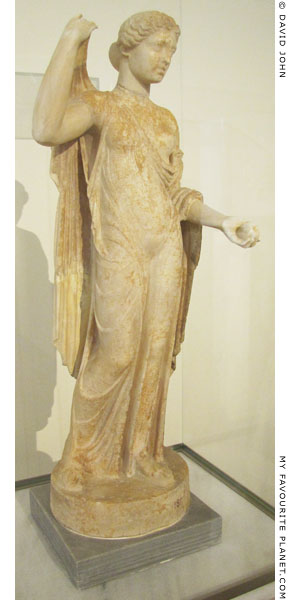
A marble statuette of Aphrodite of the
"Venus Genetrix" type, thought to have
been inspired by a bronze statue made by
Kallimachos around 410 BC (Classical
period). She is depicted either as a
goddess of vegetation and fertility, or as
a participant in the Judgement of Paris
(see Hermes). She wears a long chiton
(tunic), with her left shoulder and breast
bare, and a himation (cloak), an edge of
which she lifts over her right shoulder
with her right hand. In her left hand
she holds out an apple.
1st century AD, Roman Imperial period.
Found in the sanctuary of Apollo Maleatas
(Ἀπόλλων Μαλεάτας), on the slope of
Mount Kynortion, east of the Sanctuary
of Asklepios at Epidauros. Height 55 cm.
The statue has been restored: the head
has been reattached, and the arms and
part of the himation have been restored
with plaster.
National Archaeological Museum,
Athens. Inv. No. 1811. |
| |
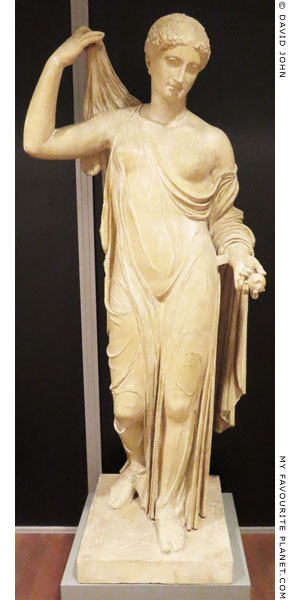
A plaster cast of the "Aphrodite Fréjus"
statue, from the original in the Louvre.
Allard Pierson Museum, Amsterdam.
Inv. No. 16.078. |
| |
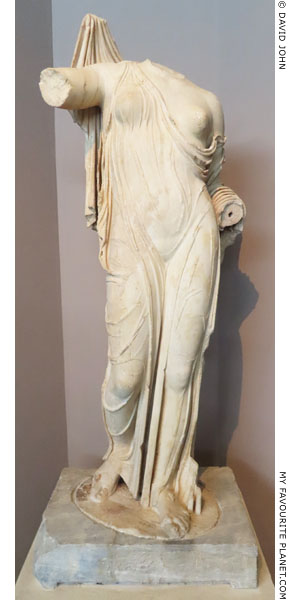
A marble statue of Aphrodite, considered
one of the best surviving examples of the
"Aphrodite Fréjus" or "Louvre-Neapolis"
type statue.
1st - 2nd century AD. From Thessaloniki.
Thessaloniki Archaeological Museum. |
| |
| |
A flowering acanthus (ἄκανθος, thorn) plant in the garden of the Rhodes Archaeological Museum, planted as a reminder of its connection with the invention of the Corinthian order, attributed by Vitruvius to Kallimachos (see above).
In the Mediterranean area one of the most common of around 30 species of the herbaceous perennial Acanthaceae plant family is Acanthus mollis, also known as bear's breeches, bear's foot plant (in German wahrer Bärenklau, true bear's claw), sea dock, sea holly or oyster plant. This example has reached a height of over 1.5 metres by mid May. |
|
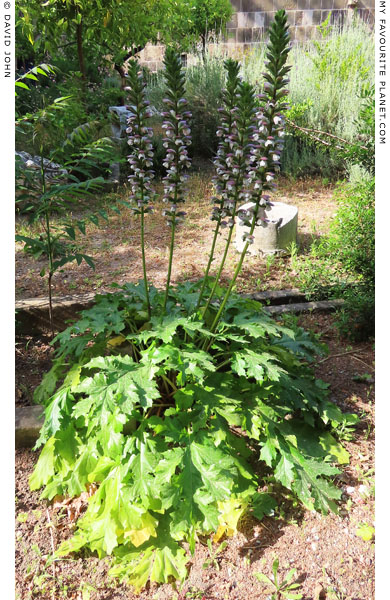 |
|
| |
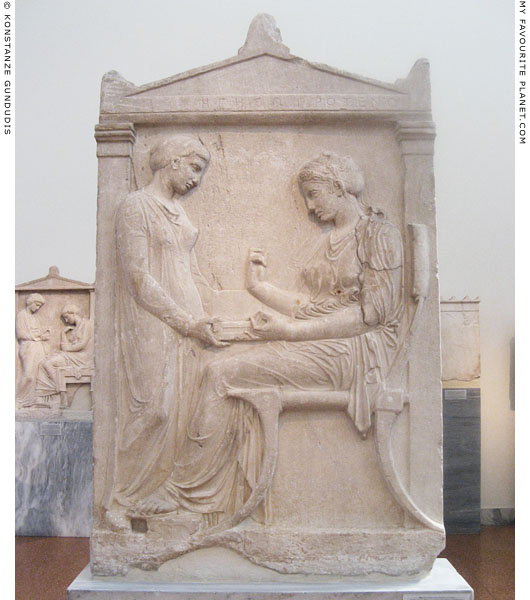
The marble grave stele of Hegeso, daughter of Proxenos,
with a relief attributed to Kallimachos.
End of the 5th century BC. Found in the ancient cemetery
of the Kerameikos, Athens. Pentelic marble.
The name of the deceased is inscribed on the epistyle of the stele. On the right of the
relief a woman sits on a chair with a footstool, facing left, and looks at a piece of jewellery,
originally painted on the stele, she held in her right hand. On the left, facing her, a young
female attendant (slave), holds open the jewellery box tha rests on the lap of her mistress.
National Archaeological Museum, Athens. Inv. No. 3624.
Photo: © Konstanze Gundudis |
| |
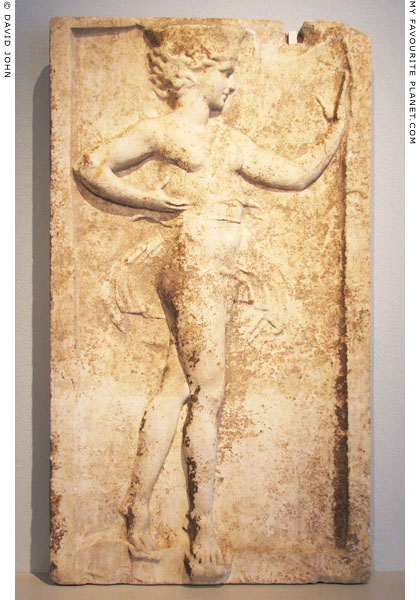
The so-called "Kalathiskos Dancer", a Neo-Attic marble relief
of a young dancing woman wearing a basket-like headdress
(kalathiskos) and a swirling, transparent chiton.
Thought to have been made in a Neo-Attic workshop in
Athens for the Roman market in the 1st century BC, as
a copy of a Classical original, perhaps by Kallimachos.
Height 95 cm, width 54 cm, depth 10 cm. Relief height 3.5 cm.
Altes Museum, Berlin. Inv. No. SK 1456.
Acquired in Florence, Italy, in 1892.
See: 2336: Relief mit Kalathiskostänzerin.
Antikensammlung, Staatliche Museen, Berlin.
At arachne.uni-koeln.de. |
| |
Kallon of Aegina
Καλλον (Latin, Callon)
Late 6th - early 5th century BC
According to Pausanias, he was a pupil of Tectaeus and Angelion, who were pupils of Dipoenos and Skyllis (early 6th century).
Quintilian also mentioned a Kallon and Hegesias (see Hegias of Athens) as examples of earlier sculptors whose work was "somewhat rude and recalls the Etruscans" (Institutio Oratoria, Book 12, chapter 10, sections 7-9; see Kalamis 1).
Only Pausanias specified two sculptors of this name: Kallon of Aegina and Kallon of Elis.
Pausanias wrote that Kallon of Aegina made the cult statue for the temple of Athena at Troezen in the Peloponnese.
"On the citadel is a temple of Athena, called Sthenias. The wooden image itself of the goddess was made by Callon, of Aegina. Callon was a pupil of Tectaeus and Angelion, who made the image of Apollo for the Delians. Angelion and Tectaeus were trained in the school of Dipoenus and Scyllis."
Pausanias, Description of Greece, Book 2, chapter 32, section 5. At Perseus Digital Library.
At Amyklai near Sparta (see Bathykles) he made a bronze tripod, probably decorated with reliefs, beneath which stood a statue of Persephone.
"The things worth seeing in Amyclae include ... There are also bronze tripods. The older ones are said to be a tithe of the Messenian war.
Under the first tripod stood an image of Aphrodite, and under the second an Artemis. The two tripods themselves and the reliefs are the work of Gitiadas [Γιτιάδας, Gitiadas of Sparta, circa 500 BC]. The third was made by Callon of Aegina, and under it stands an image of the Maid [Persephone], daughter of Demeter."
Pausanias, Description of Greece, Book 3, chapter 18, sections 7-8.
(Due to an error in this online translation, the name of Kallon appears as "Gallon", but correctly as Αἰγινήτου Κάλλωνοςin the Greek version.)
The bronze tripods, dedicated as offerings to gods, may have resembled those found at other places such Olympia, which were decorated with several reliefs depicting mythological scenes (see an example on the Medusa page).
Pausanias also noted that he was said to have lived around the same time as Kanachos of Sikyon (the Elder?), and a little earlier than Menaechmus and Soldas of Naupaktos who made a chryselephantine statue of Artemis at Patras.
"Others say that the wrath of Artemis against Oeneus weighed as time went on more lightly [elaphroteron] on the Calydonians, and they believe that this was why the goddess received her surname. The image represents her in the guise of a huntress; it is made of ivory and gold, and the artists were Menaechmus and Soldas of Naupactus, who, it is inferred, lived not much later than Canachus of Sicyon and Callon of Aegina."
Pausanias, Description of Greece, Book 7, chapter 18, Section 10. |
|
|
| |
Kallon of Elis
Καλλον (Latin, Callon)
Around 494-436 BC
From Elis, western Peloponnese.
A Kallon specifically from Elis is only mentioned by Pausanias.
The Kallon mentioned by Pliny the Elder (Natural History, Book 34, chapter 19) as a sculptor working in bronze during 87th Olympiad (430-427 BC), along with Agelades and Gorgias the Laconian (see Gorgias), is believed by some scholars to be Kallon of Elis.
Kallon of Elis made a group of 37 bronze statues at Olympia as a memorial to a chorus of 35 boys, their trainer and flautist from Messine (Μεσσήνη, today Messina), northeastern Sicily, who drowned while crossing the narrow Straits of Messina to Rhegion in southwest Italy.
"On this occasion the Messenians mourned for the loss of the boys, and one of the honours bestowed upon them was the dedication of bronze statues at Olympia, the group including the trainer of the chorus and the flautist. The old inscription declared that the offerings were those of the Messenians at the strait; but afterwards Hippias [around 436 BC], called 'a sage' by the Greeks, composed the elegiac verses on them. The artist of the statues was Callon of Elis."
Pausanias, Description of Greece, Book 5, chapter 25, section 4. At Perseus Digital Library. |
|
|
| |
Kanachos of Sikyon (the Elder)
Κάναχος (Latin, Canachus)
Late 6th - early 5th century BC.
From Sikyon, northwestern Peloponnese.
There were apparently two sculptors named Kanachos, referred to by modern scholars as the Elder and the Younger (see below). They may have been grandfather and grandson.
Pausanias does not distinguish between them, but writes that a Kanachos made two statues of Apollo (now dated to around 500 BC), and elsewhere of a Kanachos who was a pupil of Polykleitos of Argos who is thought to have been working around 460-420 BC.
Pliny the Elder's several mentions of the name are equally vague. It is uncertain which Kanachos he is referring to when he writes:
"I find it stated that Canachus, an artist highly praised among the statuaries in bronze, executed some works also in marble."
Pliny the Elder, Natural history, Book 36, chapter 4.
According to Pausanias, the brother of Kanachos (probably the Elder), Aristokles of Sikyon, was also a renowned artist.
"Ptolichus [of Aegina] was a pupil of his father Synnoon, and he of Aristocles the Sicyonian, a brother of Canachus and almost as famous an artist."
Pausanias, Description of Greece, Book 6, chapter 9, section 1. At Perseus Digital Library.
Pausanias also named Askaros of Thebes as a pupil of Kanachos of Sikyon. He wrote that Askaros made a statue of Zeus at Olympia for the Thessalians, and was of the opinion that it had been made before the Persian invasion of Greece (480-479 BC).
Pausanias, Description of Greece, Book 5, chapter 24, section 1.
Cicero, discussing the "systematic development" of sculpture by comparing the works of Kanachos, Kalamis, Myron and Polykleitos, commented that "the figures of Canachus are too stiff and formal to resemble life". Cicero, Brutus, section 70 (see full quote under Kalamis 1).
Statues of three Muses by Aristokles, Kanachos and Ageladas were described in an epigram by the Greek poet Antipater of Sidon (Ἀντίπατρος ὁ Σιδώνιος) in the 2nd century BC (see Ageladas).
Pausanias is thought to have been referring to Kanachos the Elder when describing the cedar wood statue of Apollo he made for the temple of Ismenian Apollo in Thebes, comparing it with his similar bronze statue at the sanctuary of Apollo in Didyma (Δίδυμα), in the territory of Miletus, Ionia.
"On the right of the gate is a hill sacred to Apollo. Both the hill and the god are called Ismenian, as the river Ismenus Rows by the place. First at the entrance are Athena and Hermes, stone figures and named Pronai [Of the fore-temple]. The Hermes is said to have been made by Pheidias, the Athena by Scopas.
The temple is built behind. The image is in size equal to that at Branchidae [Didyma]; and does not differ from it at all in shape. Whoever has seen one of these two images, and learnt who was the artist, does not need much skill to discern, when he looks at the other, that it is a work of Canachus. The only difference is that the image at Branchidae is of bronze, while the Ismenian is of cedar-wood."
Pausanias, Description of Greece, Book 9, chapter 10, section 2. At Perseus Digital Library.
Pausanias mentioned the Apollo at Didyma by Kanachos on another occasion, when describing the sanctuary of Aphrodite in Sikyon, for which the artist made the chryselephantine cult statue of the goddess.
"After this is the sanctuary of Aphrodite, into which enter only a female verger, who after her appointment may not have intercourse with a man, and a virgin, called the Bath-bearer, holding her sacred office for a year. All others are wont to behold the goddess from the entrance, and to pray from that place.
The image, which is seated, was made by the Sicyonian Canachus, who also fashioned the Apollo at Didyma of the Milesians, and the Ismenian Apollo for the Thebans. It is made of gold and ivory, having on its head a polos, and carrying in one hand a poppy and in the other an apple."
Pausanias, Description of Greece, Book 2, chapter 10, sections 4-5).
Pliny the Elder also mentioned a bronze statue of Apollo at Didyma by Kanachos, thought to refer to Kanachos the Elder.
"Canachus executed a nude Apollo, which is known as the 'Philesian'. It is at Didymi, and is composed of bronze that was fused at Aegina. He also made a stag with it, so nicely poised on its hoofs, as to admit of a thread being passed beneath. One fore-foots, too, and the alternate hind-foot are so made as firmly to grip the base, the socket being so indented on either side, as to admit of the figure being thrown at pleasure upon alternate feet. Another work of his was the boys known as the 'Celetizontes'."
Pliny the Elder, Natural History, Book 34, chapter 19. At Perseus Digital Library.
Pliny's description of the stag (or stags) has been described as "difficult" to comprehend or translate, but it is thought that the figure(s) could be mechanically operated.
Pliny also mentioned statues of keletizontes (κελητιζοντες, boy jockeys) by Hegias of Athens.
The Didyma statue of Apollo Philesios (Απολλων Φιλήσιος, The Lovely, or Of the Kiss) by Kanachos is thought to have been cast in Aegina around 500 BC, and to be the figure shown on coins of Miletus and on the so-called "Kanachos Relief" found in the Roman theatre of Miletus (Pergamon Museum, Berlin, Inv. No. Sk 1592; see photo below), as well as a bronze statuette in the British Museum (from Etruria, 1st century BC - 1st century AD, Inv. No. 1824,0405.1. Bronze 209). Coins of Tarsus show a similar type of statue. However, it is not certain whether it was the cult statue of the temple, since the god at Didyma was known as Apollo Dydimeus (Διδυμέυς). It may have been a votive offering for the oracle.
It is thought that the statue may have been among the artworks looted by the Persians, either by Darius I in 494 BC or by Xerxes in 479 BC, and taken to Persia, then returned during the Hellenistic period by Seleucus I Nicator (circa 358-281 BC).
"Xerxes, too, the son of Dareius, the king of Persia, apart from the spoil he carried away from the city of Athens, took besides, as we know, from Brauron the image of Brauronian Artemis, and furthermore, accusing the Milesians of cowardice in a naval engagement against the Athenians in Greek waters, carried away from them the bronze Apollo at Branchidae. This it was to be the lot of Seleucus afterwards to restore to the Milesians."
Pausanias, Description of Greece, Book 8, Chapter 46, section 3.
"I am persuaded that Seleucus was the most righteous, and in particular the most religious of the kings. Firstly, it was Seleucus who sent back to Branchidae for the Milesians the bronze Apollo that had been carried by Xerxes to Ecbatana in Persia."
Pausanias, Description of Greece, Book 1, Chapter 16, section 3.
According to Arrian of Nicomedia (2nd century AD), Alexander the Great himself ordered the return of statues looted from the Greeks by Xerxes.
See: Arrian, The Anabasis of Alexander, Book 3, chapter 16 and Book 7, chapter 19. At wikisource.
See also: Volker Michael Strocka, Der Apollon des Kanachos in Didyma und der Beginn des strengen Stils. In: Jahrbuch des Deutschen Archäologischen Instituts, Band 117 (2002), pages 81-135 with illustrations. Walter de Gruyter, 2003. At Universitätsbibliothek Freiburg. |
|
|
| |
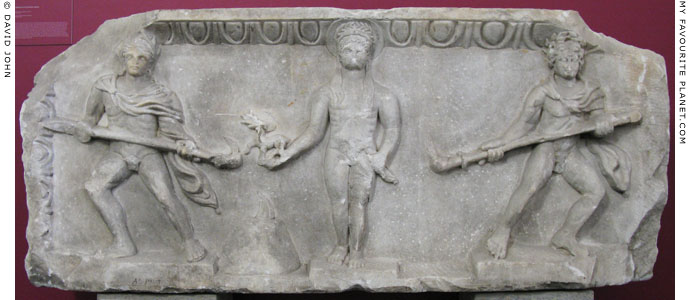
The "Kanachos Relief" thought to depict the Archaic bronze statue of Apollo Philesios, made around
500 BC by Kanachos of Sikyon (the Elder) for the sanctuary of Apollo in Didyma (Δίδυμα), Ionia.
Marble. 150-200 AD, Roman Imperial period. Found in February 1903 in the orchestra
of the Roman theatre of Miletus (Μίλητος, today Balat, Aydin Province, Turkey).
Height 79.5 cm, length 1.90 cm, depth 33 cm.
Pergamon Museum, Berlin. Inv. No. Sk 1592.
|
| The stiff-looking, kouros-type statue in the relief depicts a naked, wreathed Apollo, standing on a base, with a bow in his left hand and a deer in the right. To the left of the statue (see photo below) is a flaming, conical altar made of ashes. Either side of him is a young male figure, naked apart from a wreath and himation (cloak), holding a long torch. The torch bearers also stand on bases, but in contrast to the stiff, static pose of Apollo, they are shown in movement. |
|
|
| |
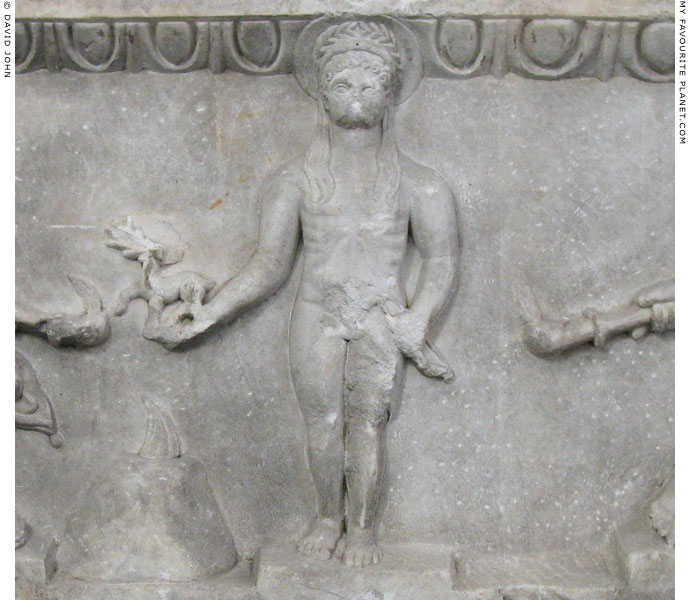
Detail of the statue of Apollo on the "Kanachos Relief" (above). |
| |
Kanachos of Sikyon (the Younger)
Κάναχος (Latin, Canachus)
Flourished around 400 BC (95th Olympiad, Pliny, Natural History, Book 34, chapter 19).
From Sikyon, northwestern Peloponnese.
A pupil of Polykleitos of Argos (Pausanias, Book 6, chapter 13, section 7), and perhaps the grandson of Kanachos the Elder.
A statue of a boy boxer at Olympia: "Bycelus, the first Sicyonian to win the boys' boxing-match, had his statue made by Canachus of Sicyon, a pupil of the Argive Polycleitus."
Pausanias, Description of Greece, Book 6, chapter 13, section 7.
With Patrokles (Πατροκλές), Kanachos made statues of the Spartan commanders Epikydidas (Ἐπικυδίδας) and Eteonikos (Ἐτεόνικος), set up in Delphi to commemorate their victory over the Athenians at the naval Battle of Aegospotami in 405 BC, at the end of the Peloponnesian War (Pausanias, Book 10, chapter 9, section 10). |
|
|
| |
Kephisodotos the Elder
Κηφισόδοτος
(Kephisodotos I or Cephisodotus the Elder)
Flourished around 400-360 BC
Athens
Placed by Pliny the Elder at the time of the 102nd Olympiad (372 BC) with Polykles, Leochares and Hypatodorus (Natural history, Book 34, chapter 19).
Perhaps the father or uncle of Praxiteles, and grandfather of Kephisodotos the Younger and Timarchos.
Pliny the Elder distinguished between two sculptors named Kephisodotos, attributing to Kephisodotos the Elder a bronze statue of Hermes holding the infant Dionysus:
"There were two artists of the name of Cephisodotus: the earlier of them made a figure of Mercury [Hermes] nursing Father Liber [Dionysus] when an infant; also of a man haranguing, with the hand elevated, the original of which is now unknown. The younger Cephisodotus executed statues of philosophers."
Pliny, Natural History, Book 34, chapter 19.
Since Praxiteles is also said to have made a statue of Hermes holding the infant Dionysus (Pausanias, Description of Greece, Book 5, chapter 17, section 3; see the Hermes page), it has been suggested that ancient authors may have confused the authorship of a single statue. However, around this time the theme of a deity carrying another god as an infant (e.g. Hermes with the infant Arkas, as well as the Tyche with the infant Ploutos and Eirene with Ploutos below) seems to have become popular as subject matter for artists.
A Herm of Hermes, the base of a statue of Hermes carrying the infant Dionysus, in the Museum of the Ancient Agora, Athens, Inv. No. S 33, is thought to be a Roman period copy of the statue group by Kephisodotos the Elder. |
|
|
| |
It is not known whether Pliny was referring to the Elder or Younger Kephisodotos in his mention of bronze statues of Athena and Zeus at Piraeus.
"Cephisodotus is the artist of an admirable Minerva [Athena], now erected in the port of Athens; as also of the altar before the Temple of Jupiter Servator [Zeus the Saviour], at the same place, to which, indeed, few works are comparable."
Pliny the Elder, Natural History, Book 34, chapter 19.
The bronze Classicistic "Piraeus Athena" statue has been attributed to either Kephisodotos or Euphranor. Piraeus Archaeological Museum. Inv. No. 4646.
Equally uncertain is Pausanias' reference to a statue group of Pentelic marble (i.e. marble from Athens) by Athenian sculptors Kephisodotos and Xenophon in the sanctuary of Zeus the Saviour (Διός Σωτῆρος, Dios Soteiros), in the agora of Megalopolis, Arcadia. The city was founded about 370 BC (see Demeter and Persephone part 2), so the statues must have been made at some time after. Archaeologists have not been able to date the scant remains of the sanctuary. Some remains identified as being of a slightly later date, suggesting that the sculptures may have been made during the generation of Kephisodotos the Younger, are considered to have been repairs or additions to the buildings.
"Here then is the Chamber, but the portico called 'Aristander's' in the market-place was built, they say, by Aristander, one of their townsfolk. Quite near to this portico, on the east, is a sanctuary of Zeus, surnamed Saviour. It is adorned with pillars round it. Zeus is seated on a throne, and by his side stand Megalopolis on the right and an image of Artemis Saviour on the left. These are of Pentelic marble and were made by the Athenians Cephisodotus and Xenophon."
Pausanias, Description of Greece, Book 8, chapter 30, section 10.
Pausanias mentioned a sculptor named "Xenophon the Athenian" when discussing a statue in Thebes (see below).
The "Artemide di Kephisodotos", found in 1873 in the Horti Vettiani, Rome, is perhaps a Roman period copy of the statue of Artemis by Kephisodotos. Palazzo dei Conservatori, Capitoline Musemus, Rome. Inv. No. MC 1123.
Pausanias noted a statue of the goddess Eirene (Εἰρήνη, Peace) holding the infant Ploutos (Πλοῦτον, Wealth) standing in the Athens Agora, but did not name the sculptor.
"After the statues of the eponymoi come statues of gods, Amphiaraus, and Eirene carrying the boy Plutus."
Pausanias, Description of Greece, Book 1, chapter 8, section 2.
Later he referred to a statue of the same subject in Athens, which he said was made by Kephisodotos. Here he also mentioned a statue representing a similar subject, Tyche (Τύχη; Latin, Fortuna) holding the infant Ploutos, in the sanctuary of Tyche at Thebes, partly made by Xenophon the Athenian. He may have been the Xenophon who worked with Kephisodotos at Megalopolis. Pausanias was delighted by the sculptors' respective concepts of the personification of Fortune or Peace as the mother or nurse of Wealth.
"After the sanctuary of Ammon at Thebes comes what is called the bird-observatory of Teiresias, and near it is a sanctuary of Fortune, who carries the child Wealth.
According to the Thebans, the hands and face of the image were made by Xenophon the Athenian, the rest of it by Callistonicus [Καλλιστόνικος], a native. It was a clever idea of these artists to place Wealth in the arms of Fortune, and so to suggest that she is his mother or nurse. Equally clever was the conception of Cephisodotus, who made the image of Peace for the Athenians with Wealth."
Pausanias, Description of Greece, Book 9, chapter 16, section 2.
It is thought that the statue of Eirene with Ploutos was set up after the peace agreement between Athens and Sparta in 375/374 BC, from which time annual sacrifices to Eirene were intitiated. The image was depicted on Athenian coins and Panathenaic prize amphorae.
For the Athenian coins, see: Friedrich Imhoof-Blumer and Percy Gardner, A numismatic commentary on Pausanias, page 147 and plate DD, ix and x. Reprinted from The Journal of Hellenic Studies, 1885, 1886, 1887. Richard Clay and Sons, London and Bungay, 1887. At the Internet Archive.
Eirene was evidently recognized as a deity in Athens long before this time. In Aristophanes' comedy Eirene (Εἰρήνη, Peace), written in 421 BC, during the Peloponnesian War, the goddess has been buried in a deep pit by the war god Ares, and Zeus has forbidden her exhumation. Nevertheless, the Athenian farmer Trygaeus persuades people from all over Greece to dig her up. She is angry with them for having rejected peace so often and refuses to speak, communicating only through Hermes. The figure of Eirene in the play has been interpreted as being a statue. At the end of the play Trygaeus prays to Peace as a familiar deity who presides over marriages and enables trade, which brings prosperity:
"Oh! Peace, mighty queen, venerated goddess, thou, who presidest over choruses and at nuptials, deign to accept the sacrifices we offer thee.
... Make excellent commodities flow to our markets, fine heads of garlic, early cucumbers, apples, pomegranates and nice little cloaks for the slaves; make them bring geese, ducks, pigeons and larks from Boeotia and baskets of eels from Lake Copais; we shall all rush to buy them..."'
The so-called "Leucothea group", a Roman period statue group found on Delos and now in Munich, is thought to be a copy of Kephisodotos' Eirene and Ploutos. Glyptothek, Munich. Inv. No. 219 (see photo, above right). There are also fragments in various collections, including a part of the Ploutos figure in the National Archaeological Museum, Athens. Studies of the Munich statue have led scholars to believe that the original was made of bronze, and that Eirene originally held a sceptre in her raised right hand.
After describing Thebes, Pausanias took his readers through Boeotia to the Grove of the Muses on Mount Helikon. He wrote that there were two groups of statues depicting the Muses, the first in which all nine were made by Kephisodotos, and the second in which Kephisodotos, Strongylion and Olympiosthenes (Ὀλυμπιοσθένης) had each made three.
"The first images of the Muses are of them all, from the hand of Cephisodotus, while a little farther on are three, also from the hand of Cephisodotus, and three more by Strongylion, an excellent artist of oxen and horses. The remaining three were made by Olympiosthenes."
Pausanias, Description of Greece, Book 9, chapter 30, section 1. |
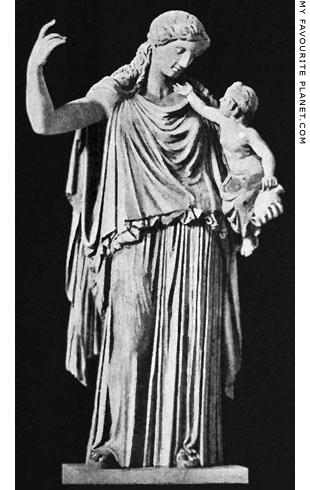
A Roman period marble statue of Eirene
holding the infant Ploutos, thought to be
a copy of the statue made by Kephisodotos
the Elder around 370 BC that stood in the
Athens Agora. Height 201 cm.
Glyptothek, Munich. Inv. No. 219.
Image source:
Ernest Arthur Gardner, A Handbook of
Greek Sculptures Part 2, Fig. 81, page 353.
Macmillan and Co., London, 1897. |
| |
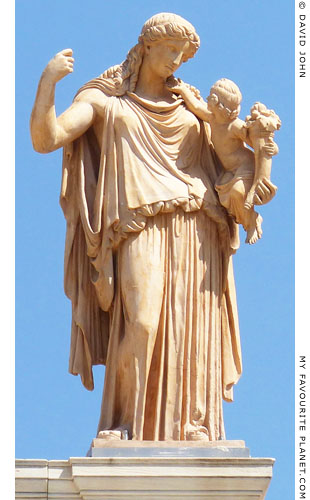
A modern copy of the statue of Eirene
holding the infant Ploutos on the roof
above the entrance to the National
Archaeological Museum, Athens. |
| |
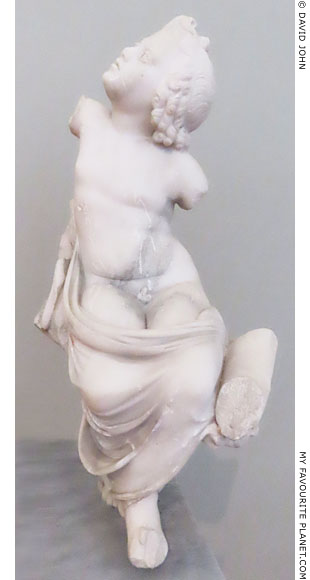
A marble statuette of Ploutos, part of a
Roman period copy of the statue of Eirene
holding the infant Ploutos by Kephisodotos
the Elder. Plouto is supported on the left
arm of Eirene, a part of whose hand can
be seen, to the right of the child's left
knee, holding part of the cornucopia.
1st century AD. Found in the
harbour of Piraeus, Greece.
National Archaeological Museum,
Athens. Inv. No. 175. |
| |
| |
Kephisodotos the Younger
Κηφισόδοτος ο Νεότερος
(Kephisodotos II or Cephisodotus the Younger)
Athens, late 4th - early 3rd century BC (around 345-290 BC)
Pliny the Elder placed him at the time of the 121st Olympiad (296 BC) with Eutychides, Euthycrates, Laippus, Timarchus (probably Timarchos), and Pyromachus (Natural history, Book 34, chapter 19).
He was the grandson of Kephisodotos the Elder, son of Praxiteles (Pliny, Book 36, chapter 4) and brother of Timarchos.
Kephisodotos the Younger was mentioned by Pliny the Elder among Greek sculptors in bronze:
"The younger Cephisodotus executed statues of philosophers."
Pliny the Elder, Natural History, Book 34, chapter 19. At Perseus Digital Library.
Pliny did not tell us which philosophers he portrayed, but listed other works by him when discussing makers of marble sculpture, including a statue group at Pergamon and others which had later been taken to Rome.
"Cephisodotus, the son of Praxiteles, inherited his father's talent. There is, by him, at Pergamus, a splendid Group of Wrestlers [symplegma], a work that has been highly praised, and in which the fingers have all the appearance of being impressed upon real flesh rather than upon marble. At Rome there are by him, a Latona [Leto], in the Temple of the Palatium; a Venus [Aphrodite], in the buildings that are memorials of Asinius Pollio [75 BC - 4 AD]; and an Aesculapius [Asklepios], and a Diana [Artemis], in the Temple of Juno situated within the Porticos of Octavia."
Pliny, Natural history, Book 36, chapter 4.
Pliny's "symplegma" has been translated in other editions simply as "persons grappling", which is a little vague. Modern scholars often refer to depictions of grappling or wrestling figures as symplegmata (from σύμπλεγμα, symplegma, braided, or entwined; plural symplegmata). See, for example, a statue group of Hermaphroditus and a satyr.
It has been suggested that the "Uffizi Wrestlers" (or "Pancrastinae"), a Roman period marble statue group found in Rome in 1583 and now in the Uffizi, Florence, Inv. No. ASN 216, may be a copy of the bronze wrestlers by Kephisodotos the Younger mentioned by Pliny. Nowever, this is just one of several theories concerning the history of the sculpture and the associated "Uffizi Niobid Group" statues.
Pausanias mentioned that a statue of Enyo (Ἐνυο, Warlike) in the sanctuary of Ares in the Athens Agora was made by "the sons of Praxiteles", but he does not name them or say how many they were. He is believed to have been referring to Kephisodotos the Younger and Timarchos (Description of Greece, Book 1, chapter 8, section 4).
Pausanias also wrote that the sons of Praxiteles built an altar that stood next to a bronze statue of Dionysus in the agora on the acropolis of Thebes, Boeotia.
"There is also a story that along with the thunderbolt hurled at the bridal chamber of Semele there fell a log from heaven. They say that Polydorus adorned this log with bronze and called it Dionysus Cadmus. Near is an image of Dionysus; Onasimedes made it of solid bronze. The altar was built by the sons of Praxiteles."
Description of Greece, Book 9, chapter 12, section 4.
A statue of Menander (Athenian comic playwright, circa 342-290 BC) at the Theatre of Dionysos, Athens, was mentioned by Pausanias (Description of Greece, Book 1, chapter 21, section 1), although he did not say who made it. A pedestal, dated 291/290 BC, discovered at the theatre in 1862, bears an inscription with the name "Menandros", below which are the signatures of Kephisodotos and Timarchos.
Μένανδρος
Κηφισόδοτος Τίμαρχος ἐπόησαν
Menandros
Kephisodotos and Timarchos made it
Inscription IG II² 3775.
This is thought have been the base of the bronze statue seen by Pausanias. From this and other epigraphical evidence it is also believed that the two sculptors were brothers and the sons of Praxiteles. The pedestal is displayed at the theatre, with a modern composite cast reconstruction of the statue of the seated playwright, made from fragments of Roman period copies (in Naples and Venice). 71 Roman copies of the statue's head have survived, more than of any other ancient poet's portrait, as well as nine replicas of the body.
After describing Thebes, Pausanias took his readers through Boeotia to the Grove of the Muses on Mount Helikon (see below). He wrote that there were two groups of statues depicting the Muses, the first in which all nine were made by Kephisodotos, and the second in which Kephisodotos, Strongylion and Olympiosthenes (Ὀλυμπιοσθένης) had each made three.
"The first images of the Muses are of them all, from the hand of Cephisodotus, while a little farther on are three, also from the hand of Cephisodotus, and three more by Strongylion, an excellent artist of oxen and horses. The remaining three were made by Olympiosthenes."
Pausanias, Description of Greece, Book 9, chapter 30, section 1. |
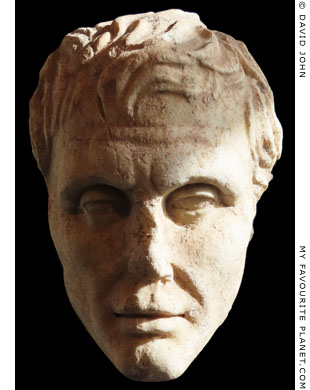
Marble portrait head of Menander.
2nd century BC, Roman Imperial period.
Pentelic marble. Although only the face
and front of the head have survived, this
is one of the best preserved examples
of the type believed to be copies of the
bronze statue made by Kephisodotos
and Timarchos for the Theatre of Dionysos,
Athens, soon after 291 BC.
Antikenhalle (Hall of Antiquities),
Semperbau, Dresden. Inv. No. Hm 198.
Donated by Franz Studniczka, Leipzig, 1899. |
| |

Marble portrait head of Menander
from Corfu.
Roman Imperial period, first half of
the 2nd century AD. Height 29.5 cm.
Corfu Archaeological Museum.
Inv. No. 133.
See the statue of Menander and the
inscribed pedestal at the theatre
on Athens Acropolis page 36. |
| |
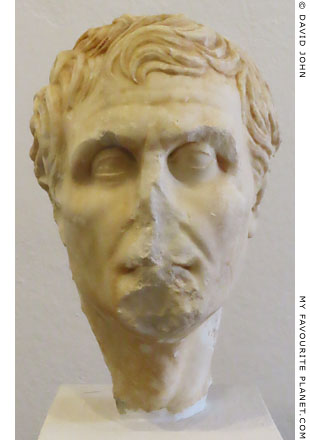
Marble portrait head of Menander
from Rhodes.
Rhodes Archaeological Museum. |
| |
| |
In a dialogue written by the early Hellenistic poet Herondas, two characters, Kynno and Kokkale, discuss altars and statues of Asklepios, "Lord Paieon, ruler of Trikka", his parents (Koronis and Apollo) and children. Kynno says that according to the inscription on the base, they were made by "the sons of Praxiteles". It is thought that the scene may have been set in the Asklepieion on the island of Kos.
"Kynno: Hail, Lord Paieon, ruler of Trikka, who dwells in sweet Kos and Epidauros too; hail Koronis too, who bore you, and Apollo, and Hygieia whom you touch with your right hand, and those whose honoured altars are here too; hail to Panake, Epio, Ieso, and those who sacked house and walls of Leomedon, doctors of savage diseases, Podaleirios and Machaon, and all the gods and goddesses who inhabit your shrine, father Paieon. Come gracefully to accept this cock . . .
Kokkale: O Kynno dear, what fair statues! What craftsman, pray, made this stone, and who set it up?
Kynno: The sons of Praxiteles: don't you see the letters on the base? And Euthies son of Prexon set it up.
Kokkale: May Paieon be gracious with them and to Euthies for their fair works. [They then turn to admire other dedications before entering the temple with their offering]."
Herondas, Mimiambos, 4.
According to the Syrian theologian Tatian (Τατιανός, circa 120-180 AD), Kephisodotos made bronze statues of poetesses, one of Myro of Byzantium, and with Euthykrates one of Anyte of Tegea. He said they were among works by renowned Greek sculptors which had been taken to Rome (see the quote under Menestratos). Since Myro (Μυρώ; or Moero, Μοιρώ) probably lived in the late 4th to early 3rd century BC, it is thought more likely that her statue was made by the younger rather than the elder Kephisodotos.
Several statue bases signed by Kephisodotos the Younger have been discovered, including an early 3rd century BC dedication to Athena by Philoumene, daughter of Leosthenes, found at the Athens Acropolis. Acropolis Museum. Inv. No. Acr. Y 3627. A few, including the base of the Menander statue, are also signed by Timarchos. There is only one known signature of Timarchos alone, found at Rome in 1874.
Some scholars believe that around 290 BC Kephisodotos and Timarchos made a marble statue of Aphrodite known by copies of the Capitoline Aphrodite type, named after the best example. Capitoline Museums, Rome. Inv. No. 409. 2nd century AD. Height 193 cm. It was found near the church of San Vitale, between the Quirinal and Viminal, Rome. |
| |
| |
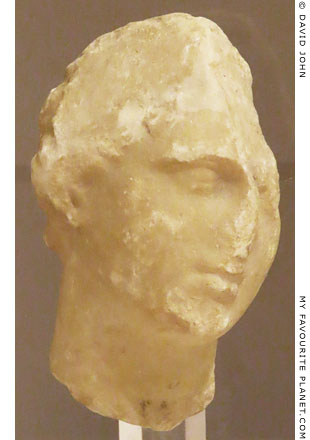 |
|
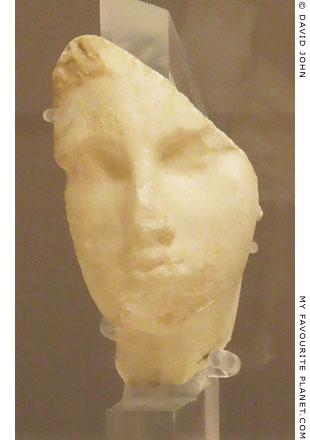 |
Two fragmentary marble smaller than lifesize statue heads of females, found in the
Asklepieion of Kos. 340-330 BC. Attributed to the workshop of Praxiteles' sons.
Kos Archaeological Museum. |
|
| |
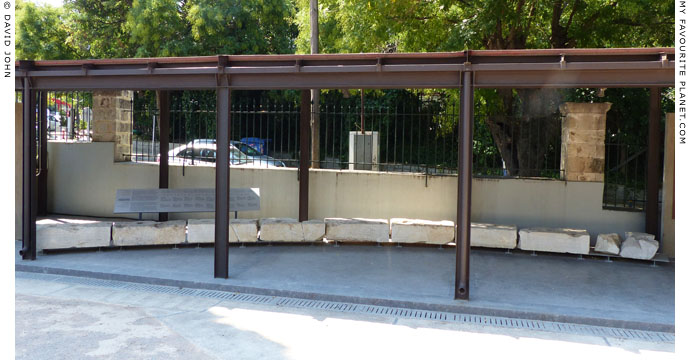
Nine inscribed marble blocks from the base for bronze statues of the nine Helikonian Muses,
from the sanctuary of the Muses on Mount Helikon, near Thespiai, Boeotia, central Greece.
1st century BC, during the reign of Augustus.
Courtyard of Thebes Archaeological Museum.
|
The sanctuary of the Muses, the patron goddesses of the arts and sciences, in the Grove of the Muses, near Thespiai, was one of the most important centres for their cult. It flourished particularly during the Hellenistic and early Roman Imperial periods. Among the many statues of the Muses set up there were the bronzes which stood on this base, dedicated by the Thespians. Inscribed below the figure of each Muse was her name and a short epigram in her honour by the Corinthian poet Onestos.
Pliny the Elder (Natural history, Book 36, chapter 4) wrote that the artist and art historian Pasiteles "speaks in terms of high admiration" of a statue group of the Thespian Muses, the "Thespiades", taken from Thespiae to Rome by consul Lucius Mummius Achaicus (the conquerer of Achaia who destroyed Corinth in 146 BC) and set up near the Temple of Felicity. Unfortunately Pliny did not describe the statue group or tell us who made it. In the same chapter Pliny attributed another group of "Thespiades" in the buildings of Asinius Pollio in Rome to Cleomenes, but did not specify which of the artists of this name was meant. See Pasiteles for further details. |
|
|
| |
Klearchos of Rhegion
Κλέαρχος (Clearchus of Rhegium)
Early 5th century BC
Rhegion (Ῥήγιον; Latin, Rhegium), southwest Italy
He was a pupil of Eucheiros (Εὔχειρος) of Corinth and the teacher Pythagoras of Rhegion, who was a contemporary of Myron and Polykleitos the Elder.
The only known work by Klearchos was a statue of Zeus Most High (Διὸς Ὑπάτος, Dios Ypatos) at Sparta mentioned by Pausanias, made from hammered bronze plates riveted together. Pausanias related that it was the most ancient bronze statue and that Klearchos was said to have been been a pupil of Dipoenos and Skyllis (6th century BC) or Daidalos, either the mythical Daidalos or Daidalos of Sikyon (5th - 4th century BC).
"On the right of the Lady of the Bronze House has been set up an image of Zeus Most High, the oldest image that is made of bronze. It is not wrought in one piece. Each of the limbs has been hammered separately; these are fitted together, being prevented from coming apart by nails. They say that the artist was Clearchus of Rhegium, who is said by some to have been a pupil of Dipoenus and Scyllis, by others of Daedalus himself."
Pausanias, Description of Greece, Book 3, chapter 17, section 6.
Later, when discussing a statue at Olympia by Pythagoras of Rhegion, Pausanias provided a very different account of Klearchos:
"The statue was made by Pythagoras of Rhegium, an excellent sculptor if ever there was one. They say that he studied under Clearchus, who was likewise a native of Rhegium, and a pupil of Eucheirus. Eucheirus, it is said, was a Corinthian, and attended the school of Syadras and Chartas, men of Sparta."
Pausanias, Description of Greece, Book 6, chapter 4, section 4. |
|
|
| |
Kresilas
Κρησίλας; Latin, Cresilas; also referred to as Ctesilas or Ctesilaüs
From Kydonia (Κυδωνία, today Chania), on the north coast of Crete.
Circa 480-410 BC
He is thought to have been a student of Dorotheos of Argos (Δωρόθεος), and may have worked with him at Delphi and Hermione. This theory is mainly based on the discovery of signatures of the two artists on the bases of related statues at both places (see Kresilas signatures on the Kresilas page).
From literary and epigraphical evidence, he appears to have worked between around 450 and 410 BC mainly in Athens, probably as a follower of the school of Myron, known for its idealistic portraiture. |
|
For further information see the Kresilas page. |
|
|
| |
Kritios
Κριτίος or Κριτίας (Latin, Critius or Critias)
Working in Athens, early-mid 5th century BC
Pliny the Elder (Natural History, Book 34, chapter 19)
placed "Critias" in the 83rd Olympiad (448-445 BC), about the year of our City 300 (years since the legendary foundation of Rome in 753 BC), along with Pheidias, Alcamenes, Nesiotes (or perhaps "Nestocles") and Hegias. As pupils of Critias, later in the same chapter Pliny named Diodorus and Scymnus, among celebrated artists "who had not produced any first-rate works".
He was probably a pupil of Antenor, and was a teacher of Ptolichus of Korkyra (Πτόλιχος ὁ Κορκυραῖος; Korkyra is today known in English as Corfu). Pausanias discussed the school of "Attic Kritias" while describing statues of athletes in the Sanctuary of Zeus at Olympia:
"The statue of Hippus of Elis, who won the boys' boxing-match, was made by Damocritus of Sicyon [Δαμόκριτος Σικυώνιος], of the school of Attic Critias [τὸν Ἀττικὸν Κριτίαν], being removed from him by four generations of teachers. For Critias himself taught Ptolichus of Corcyra, Amphion [Ἀμφίων] was the pupil of Ptolichus, and taught Pison of Calaureia [Πίσων Καλαυρείας], who was the teacher of Damocritus."
Pausanias, Description of Greece, Book 6, chapter 3, section 5. At Perseus Digital Library.
Kritios and Nesiotes made the statue pair of the "Tyrannicides" (Τυραννοκτόνοι) Harmodius and Aristogeiton (Ἁρμόδιος καὶ Ἀριστογείτων), who in 514 BC assassinated Hipparchos, one of the sons and successors of the Athenian tyrant Peisistratos, and were then themselves killed. The statues were set up in the Athenian Agora in 477 BC to replace those made Antenor, which had been taken as booty by Xerxes I of Persia in 480 BC. Pausanias summarized the tale of the statues, but did not mention Nesiotes:
"Hard by stand statues of Harmodius and Aristogiton, who killed Hipparchus. The reason of this act and the method of its execution have been related by others; of the figures some were made by Critius, the old ones being the work of Antenor. When Xerxes took Athens after the Athenians had abandoned the city he took away these statues also among the spoils, but they were afterwards restored to the Athenians by Antiochus."
Pausanias, Description of Greece, Book 1, chapter 8, section 5. At Perseus Digital Library.
The Roman period copy of the statue group, now in Naples, may have been made from plaster casts of the originals in a copyist's workshop in Baiae in the Bay of Naples, where in 1952 part of a cast of the head of Aristogeiton (Baiae Museum. Inv. No. 174.479) was discovered.
National Archaeological Museum, Naples. Inv. No. G 103 and G 104.
Pausanias also noted a statue of the athlete Epicharinos (Ἐπιχαρίνος) by Kritios (Κριτίας) near a bronze statue of the Wooden Horse of Troy on the Athens Acropolis.
"Of the statues that stand after the horse, the likeness of Epicharinus who practised the race in armour was made by Critius..."
Pausanias, Description of Greece, Book 1, chapter 23, section 19. At Perseus Digital Library.
Lucian of Samosata referred to the stiff Archaic style of Hegesias (see Hegias of Athens), Kritios and Nesiotes:
"... the clean-cut, sinewy, hard, firmly outlined productions of Hegesias, or the school of Critius and Nesiotes."
Lucian, The rhetorician’s vade mecum (written around 178 AD).
The smaller than lifesize marble statue of a nude youth known as "the Kritian Boy" (or "Kritios Boy"), found on the Athens Acropolis in 1865 (the head in 1888), has been named due to similarities of the head to that of the statue of Harmodius (the younger of the tyrannicides). Dated around 480 BC, it is considered to be the earliest explicit example of Classical sculpture and a radical departure from Archaic kouros statue types (see, for example the colossal "Isches Kouros", "the Ram-Carrier of Thasos" and "the Strangford Apollo", on Samos gallery page 4).
Acropolis Museum, Athens. Inv. No. Acr. 698.
Height 116.7 cm.
A new article about Kritios and Nesiotes is currently in preparation. |
|
|
| |
| Sculptors |
L |
|
 |
|
| |
| |
Leochares
Λεοχάρης (Lion’s Grace)
4th century BC, working around 370-320 BC
Athens
According to Pliny the Elder (Natural History, Book 34, chapter 19), Leochares was working in bronze in the 102nd Olympiad (370 BC), as a contemporary of Kephisodotos the Elder, Polykles and Hypatodorus. However, many scholars believe this date is far too early for the height of his career, particularly taking into consideration the projects he is said to have worked on and the other artists he worked with.
Leochares made chryselephantine (ivory and gold) statues for the Philippeion at Olympia (see Alexander the Great), commissioned by Philip II of Macedonia following his victory at the Battle of Chaeroneia in 338 BC, and probably completed during the reign of his son Alexander the Great. Pausanias mentioned statues there of Philip, Alexander, Olympias (Alexander's mother), Amyntas III and Eurydice I (Philip's parents).
Pausanias, Description of Greece, Book 5, chapter 20, sections 9-10.
See: Katherine Denkers, The Philippeion at Olympia: The true image of Philip? MA thesis, McMaster University, 2012.
Marble head of Alexander the Great, 340-330 BC. Thought to be an original work of Leochares. Found in 1886 near the Erechtheion of the Athens Acropolis. It has been suggested that the portrait of Alexander in the Philippeion at Olympia (see Alexander the Great) may have been a copy of this sculpture. Acropolis Museum, Athens. Inv. No. Acr. 1331.
Plutarch wrote that Leochares and Lysippos made a bronze statue group depicting Alexander and his general Krateros hunting a lion, which was dedicated by Krateros at Delphi. Pliny the Elder also mentioned a bronze statue of Alexander hunting by Lysippos, "now consecrated at Delphi", but did not mention that Leochares worked on the sculpture. This is thought to have been one of Leochares' last works and to have been made around 320 BC. The site of the monument known as the "Offering of Krateros" or the "Ex-voto of Krateros" has been discovered in Delphi, along with the inscribed dedication by the son of Krateros (see Alexander the Great).
Plutarch, Life of Alexander, chapter 40, section 5; Pliny the Elder, Natural history, Book 34, chapter 19.
Leochares made a statue of Apollo (probably around 338-322 BC) which stood next to one by Kalamis in front of the Temple of Apollo Patroos (Paternal) in the Athenian Agora (Pausanias, Description of Greece, Book 1, chapter 3, section 4; see Euphranor). He made a statue of Zeus which stood on the Athens Acropolis, and which Pausanias included in a list of Athenian monuments he recommended to "those who prefer artistic workmanship to mere antiquity" (Pausanias, Book 1, chapter 24, sections 3-4). He also made statues of Zeus and the People (Δῆμος, Demos) which stood in the sanctuary of Athena and Zeus at Piraeus (Pausanias, Book 1, chapter 1, section 3).
Around 350 BC he made sculptures for the Mausoleum of Halicarnassus in Caria, western Anatolia (today Bodrum, Turkey), with Bryaxis, Skopas, and perhaps Timotheos and Praxiteles. According to Pliny the Elder, he worked on the west side of the monument. (Vitruvius, Ten books on architecture, Book 7, Introduction, section 13; Pliny the Elder, Natural history, Book 36, chapter 4; see Bryaxis)
According to Vitruvius, either Leochares or Timotheos made a colossal acrolithic statue of Ares for the temple of Ares in Halicarnassus:
"At the top of the hill, in the centre, is the fane of Mars, containing a colossal acrolithic statue by the famous hand of Leochares. That is, some think that this statue is by Leochares, others by Timotheus."
Vitruvius, Ten books on architecture, Book 2, chapter 8, section 11.
Other bronze sculptures by Leochares mentioned by Pliny:
"Leochares made a bronze representing the eagle carrying off Ganymede: the eagle has all the appearance of being sensible of the importance of his burden, and for whom he is carrying it [Zeus], being careful not to injure the youth with his talons, even through the garments. He executed a figure, also, of Autolycus, who had been victorious in the contests of the Pancratium, and for whom Xenophon wrote his Symposium; the figure, also, of Jupiter Tonans in the Capitol, the most admired of all his works; and a statue of Apollo crowned with a diadem. He executed, also, a figure of Lyciscus, and one of the boy Lagon, full of the archness and low-bred cunning of the slave."
Pliny the Elder, Natural history, Book 34, chapter 19.
The figure of Autolycus (Αὐτόλυκος), a champion in the pankration (παγκράτιον, a no-holds-barred mixture of boxing and wrestling), perhaps in the Panathenaic games of 422 BC, may have been the statue reported by Pausanias as standing in the Prytaneion (Πρυτανεῖον, town hall), below the eastern end of the Athens Acropolis. Some scholars believe that Pliny's text is confused, and that the statue may have been made by Lykios (see Lykios below).
"Hard by is the Prytaneum, in which the laws of Solon are inscribed, and figures are placed of the goddesses Peace [Εἰρήνη, Eirine] and Hestia [Ἑστία], while among the statues is Autolycus the pancratiast."
Pausanias, Description of Greece, Book 1, chapter 18, section 3.
The statue of Jupiter Tonans (Ζεὺς βρονταῖος, Zeus Brontaios, Thundering Zeus), made of Delian bronze (Natural history, Book 34, chapter 5), is thought to have been an early work of Leochares which stood in Megalopolis, Arcadia (founded about 370 BC, see Demeter and Persephone part 2). It was later taken to Rome and set up by Augustus in the Temple of Jupiter Tonans he built on the Capitol of highly polished solid blocks of marble (Natural history, Book 36, chapter 8).
Leochares' signature has been found on 10 statue bases in Athens, many fragmentary and incomplete. They include:
A dedication to Asklepios, around 338 BC. Inscription IG II² 2831+4367 (also IG II² 2831, IG II² 4367 and SEG 30:163).
A dedication by officials, mid 4th century BC. Inscription IG II³ 463. Epigraphical Museum, Athens, Inv. No. EM 10601).
The dedication of Pandaites and Pasikles, a base for a group of five statues of Pasikles of Potamos and his family, around 330 BC. Two statues are signed by Sthennis and two by Leochares. The signature for the fifth statue is missing. Inscription IG II² 3829.
For seven of the signatures of Leochares, see: Emanuel Loewy (1857-1938), Inschriften griechischer Bildhauer, Nos. 77-83, pages 60-65. B. G. Teubner, Leipzig, 1885. At Heidelberg University Digital Library. |
|
|
| |
Lykios
Λύκιος (Latin, Lycius)
Mid 5th century BC
From Eleutherai (Ἐλευθεραί), near the border between northern Attica and Boeotia. He worked at Athens and Olympia.
Son and/or pupil of Myron of Eleutherai (son, according to Pausanias, Description of Greece, Book 1, chapter 23, section 7, and Book 5, chapter 22, section 3; pupil, according to Pliny the Elder, Natural History, Book 34, chapter 19).
For more about Eleutherai and Athens, see Athens Acropolis gallery page 36.
Statues by Lykios in Athens and Olympia are known from literary and epigraphical evidence. He appears to have continued the work of his father and/or teacher Myron. Like other contemporary sculptors working in Athens, he was probably involved in the Periclean building project on the Acropolis, although there appears to be no evidence for modern claims that he worked there as an architect.
Pausanias saw a statue of a boy holding a perirrhanterion (περιρραντήριον, a vessel or sprinkler for holy water) by Lykios, next to Myron's statue of Perseus on the Athens Acropolis, perhaps just inside the Propylaia, near the sanctuary of Athena Hygieia, in front of the sanctuary of Artemis Brauronia.
"I remember looking at other things also on the Athenian Acropolis, a bronze boy holding the sprinkler, by Lycius son of Myron, and Myron's Perseus after beheading Medusa."
Pausanias, Description of Greece, Book 1, chapter 23, section 7. At Perseus Digital Library.
He also described an extensive group of statues near the Hippodamion (Ἱπποδάμιον) in Olympia, made by Lykios for Apollonia (Ἀπολλωνία πρὸς Ἐπίδαμνον, Apollonia pros Epidamnon; in Illyria or Epirus; today near Pojani, Albania) on the Ionian Sea, a colony of Korkyra (Corfu). The statues depicted scenes from the Epic Cycle of poems dealing with the Trojan War (see Homer). In one scene Thetis (mother of Achilles) and Hemera (Eos, mother of Memnon) made pleas to Zeus for the lives of their respective sons. The other sculptures included five pairs of Homeric heroes in duels:
"By the side of what is called the Hippodamium is a semicircular stone pedestal, and on it are Zeus, Thetis, and Day [Hemera] entreating Zeus on behalf of her children. These are on the middle of the pedestal. There are Achilles and Memnon, one at either edge of the pedestal, representing a pair of combatants in position. There are other pairs similarly opposed, foreigner against Greek: Odysseus opposed to Helenus, reputed to be the cleverest men in the respective armies; Alexander [Paris] and Menelaus, in virtue of their ancient feud; Aeneas and Diomedes, and Deiphobus and Ajax son of Telamon.
These are the work of Lycius, the son of Myron, and were dedicated by the people of Apollonia on the Ionian sea."
Pausanias, Description of Greece, Book 5, chapter 22, sections 2-3. At Perseus Digital Library.
Two fragments of black limestone found at Olympia, inscribed at the edges at which they join with the name Memnon (Μέμνων), are thought to be parts of the semicircular pedestal on which Lykios' statue group stood.
Μέμνω - ν
Inscription IvO 692 at The Packard Humanities Institute.
Height 30.5 - 31.5 cm, combined width 54 cm, depth 88 cm.
See: Ernst Curtius and Friedrich Adler (editors), Olympia: die Ergebnisse der von dem Deutschen Reich veranstalteten Ausgrabung, Wilhelm Dittenberger and Karl Purgold, Textband 5: Die Inschriften von Olympia, No. 692, columns 711-712. A. Ascher & Co., Berlin, 1896. At Heidelberg University Digital Library.
Athenaeus of Naucratis (2nd - 3rd century AD), citing Polemo (probably the geographer Polemo Periegetes, also cited by Strabo), referred to Lykios as a Boeotian from Eleutherai and a son of Myron. He refuted a claim by the grammarian Didymos that he made vessels known as φίαλας λυκουργεῖς (Lykian or Lycian phiales) or λυκιουργεῖς (Lykiourgeis, Lycian cups or Lycian ware) mentioned in a speech by Demosthenes.
"There is also the Lyciurges. The things which are so called are some kinds of phialae, which derive their name from Lycon who made them, just as the Cononii are the cups made by Conon. Now, Demosthenes, in his Oration for the Crown, mentions Lycon; and he does so again, in his oration against Timotheus for an assault, where he says, 'two lyciurgeis Phialae'. And in his speech against Timotheus he also says, 'He gives Phormion, with the money, also two lyciurgeis Phialae to put away'. And Didymus the grammarian says that these are cups made by Lycius. And this Lycius was a Boeotian by birth, of the town of Eleutherae, a son of Myron the sculptor, as Polemo relates in the first book of his treatise on the Acropolis of Athens; but the grammarian is ignorant that one could never find such a formation of a word as that derived from proper names, but only from cities or nations."
Athenaeus, The Deipnosophists, Book 11, chapter 72. At Perseus Digital Library.
The same information appears in the Suda, where it is argued that such vessels were named after Lycia in southwest Anatolia:
"Λυκιουργίς: Lykian-ware, Lycian-ware: Demosthenes in the [speech] Against Timotheos uses the expression. Didymos asserts that the bowls manufactured by Lykios the son of Myron were referred to in this way. But the grammarian seems to be unaware that one would not find such an expression arising from proper names, rather from cities and peoples; like 'a couch Milesian-made' and the like. So perhaps one should write, in Herodotus [book] seven, not two hunting-spears 'wolf-made' but 'Lykian-made', in order that, just as in Demosthenes, they may be described as being of Lykian manufacture."
Suda, § la.807. At ToposText.
This rather involved pedantic argument has led modern scholars to ask whether Lykios did make such vessels, perhaps chased silver phiales (libation bowls), as other sculptors are said have done, including Myron and Kalamis.
Pliny the Elder named Lykios as a pupil of Myron in a list of sculptors in bronze. A little later in the same chapter he mentioned a statue of a boy and a statue group of the Argonauts. After continuing with works by Leochares, he adds another statue of a boy by Lykios. Some scholars have considered this confusing text may actually have meant that Lykios also made one or more of the statues ascribed to Leochares, particularly the statue of Autolycus.
"Lycius, too, was the pupil of Myron."
"Lycius was the pupil of Myron: he made a figure representing a boy blowing a nearly extinguished fire, well worthy of his master, as also figures of the Argonauts. Leochares made a bronze representing the eagle carrying off Ganymede: the eagle has all the appearance of being sensible of the importance of his burden, and for whom he is carrying it, being careful not to injure the youth with his talons, even through the garments. He executed a figure, also, of Autolycus, who had been victorious in the contests of the Pancratium, and for whom Xenophon wrote his Symposium; the figure, also, of Jupiter Tonans in the Capitol, the most admired of all his works; and a statue of Apollo crowned with a diadem. He executed, also, a figure of Lyciscus, and one of the boy Lagon, full of the archness and low-bred cunning of the slave. Lycius also made a figure of a boy burning perfumes."
Pliny the Elder, Natural history, Book 34, chapter 19.
An inscribed grey marble statue base (perhaps Pentelic or Hymettian marble) signed by Lykios, son of Myron, and dated around 450-430 BC, was found in 1889 near southwest corner of the Parthenon, on the Athens Acropolis. Dowel holes in the top of the base (see drawing below) indicate that the statue was of a horse (with or without a rider), facing right, being led by a man standing next to it. The monument was dedicated by three cavalry generals (hipparchs) to commemorate a battle, although its place and date remain a subject of debate.
ℎοι ℎι[ππ]ῆς [⋮] ἀπὸ τ̣ο͂ν [πο]λεμίον ⋮ ℎιππαρ[χ]ό[ν]-
τον ⋮ Λακεδ̣αιμονίο [⋮] Ξ̣[ε]νοφο͂ντος ⋮ Προν[ά]π[ο]-
ς ⋮ Λύκιο[ς ⋮ ἐ]ποίησεν [⋮] Ἐλευθερεὺς [⋮ Μ]ύ̣[ρ]ο̣ν̣[ος].
The cavalry [dedicated this] from [the spoils of] the enemy. The cavalry commanders
were Lakedaimonios, Xenophon, Pronapes.
Lykios of Eleutherai, son of Myron, made it.
Inscription IG I³ 511 (= IG I² 400,Ia; Antony E. Raubitschek, Dedications from the Athenian Akropolis [DAA], No. 135) at The Packard Humanities Institute.
In the early Roman Imperial period, probably in the 1st century BC during the reign of Augustus, the base was turned on its head and reinscribed on the opposite side with an exact copy of the original dedication in archaistic early Attic lettering. IG I² 400,Ib (DAA 135a). The statue placed on the reused based is thought to have been a newly-made work of a similar type, although probably not a copy of Lykios' group, since the dowel holes are distributed differently.
Around the same time another, apparently new base of grey Hymettian marble was also inscribed with a copy of the dedication in the same archaistic lettering, but by a different stonemason. Three fragments of the inscription were discovered at different times in various places around the Acropolis IG I² 400,II (DAA 135b). The findspots of two fragments are unknown, but "Fragment b" was found in 1880, built into a late wall to the west of the Pedestal of Agrippa.
Later, another block of the first pedestal (DAA 135a) was inscribed again, apparently presenting the statue as a dedication by the demos (the people) to Germanicus Caesar, the adopted son and heir of Emperor Tiberius (reigned 14-37 AD). This may have been made at the time of Germanicus' visit to Athens in 18 AD.
ὁ δῆμος
Γερ[μ]ανικ[ὸν Κα]ίσαρα
θεοῦ Σε[βαστοῦ ἔγγονον].
The demos [dedicated this statue of]
Germanicus Caesar,
descendant of the divine Augustus.
Inscription IG II² 3260 (see DAA 135, 135a, 135b) at The Packard Humanities Institute.
It is therefore believed that Lykios' original statues may have been destroyed or moved elsewhere (perhaps taken to Rome?), and later replaced by two equestrian statues on similar bases, perhaps standing on a single pedestal. Later one or both of the statues were rededicated to Germanicus Caesar. It is also thought that these may have been the statues Pausanias saw on his way up to the Propylaia of the Athens Acropolis, and that he may have been confused or bemused by the extra dedication to Germanicus. The two early Imperial statues may have depicted Gryllus and Diodorus, sons of the general Xenophon of Athens, or the Dioskouroi standing with horses.
"Now as to the statues of the horsemen, I cannot tell for certain whether they are the sons of Xenophon or whether they were made merely to beautify the place."
Pausanias, Description of Greece, Book 1, chapter 22, section 4. At Perseus Digital Library.
The original inscription and the dedication to Germaninus have been placed on the bastion of the Athena Nike Temple. See a photo, drawings and further discussion on Athens Acropolis page 8.
See also:
Lilian Hamilton Jeffery, Lykios son of Myron: the epigraphic evidence. In: Στήλη Τόμος Εις Μνήμην Νικολάου Κοντολέοντος, pages 51-54. 1971.
Jerome Jordan Pollitt, The art of ancient Greece: sources and documents, Chapter 5, pages 69-71. Cambridge University Press, 1990. At Google Books.
A fragment of another statue base, made of limestone, with a now incomplete two-line inscription thought to include a dedication and Lykios' signature, was found in 1865, northeast of Propylaia. The forms of the lettering are similar to those on the cavalry monunent above (DAA 135). It is not certain whether both lines are part of the same inscription, and reconstruction has posed problems for scholars. It is is thought that Lykios may have dedicated the statue himself, perhaps around 440-430 BC. According to another interpretation, the first line may be a dedication by Semichides of Eleutherai (before 440 BC), and the second the signature of Lykios of Eleutherai, son of Myron.
[Ἀθεναίαι ἀπαρχὲν Σεμιχίδ]ες Ἐλευθερε[ὺς ἀνέθεκεν]
[Λύκιος ἐποίεσεν Ἐλευθερεὺς] Μύρονος. [vac.]
Inscription DAA 138 at The Packard Humanities Institute.
Epigraphical Museum, Athens. Inv. No. EM 6272.
Height 15 cm, length 26 cm, width 8 cm. The top of the slab is smooth, with no traces of cutting.
See also IG I³ 892 (also IG I² 537) at The Packard Humanities Institute.
It has been suggested that the statue which stood on this base may have been Lykios' bronze boy holding a perirrhanterion mentioned by Pausanias. |
|
|
| |
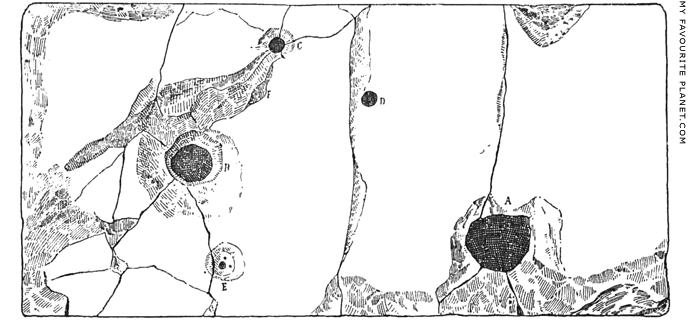
A drawing of the top of the base of the cavalry statue group by Lykios on the
Athens Acropolis (see above), showing the dowel holes for affixing the statues.
Source: Carlo Anti, Lykios, Fig. 9, page 40. In: Bullettino della Commissione
Archeologica Comunale di Roma, Anno 47 (1919), pages 55-138.
P. Maglione & C. Strini, Rome, 1921. At Heidelberg University Digital Library. |
| |
Lysippos
Λύσιππος (Latin, Lysippus)
Circa 390-305 BC
Born at Sikyon, northeastern Peloponnese.
An autodidact, he was originally a metal smith, became a prolific sculptor, and later head of the school of Argos and Sikyon.
He was the official sculptor of Alexander the Great, and, according to Plutarch, the only artist permitted to portray him in statues. Plutarch also mentioned that he made a statue of Alexander holding a spear and compared it to the painting by Apelles of Alexander with a thunderbolt (Moralia, 335A-B, 335F and 360D).
Moralia, 335A-B
"Apelles the painter and Lysippus the sculptor also lived in the time of Alexander. The former painted 'Alexander wielding the Thunderbolt' so vividly and with so natural an expression, that men said that, of the two Alexanders, Alexander, son of Philip, was invincible, but the Alexander of Apelles was inimitable.
And when Lysippus modelled his first statue of Alexander which represented him looking up with his face turned towards the heavens (as indeed Alexander often did look, with a slight inclination of his head to one side), someone engraved these verses on the statue, not without some plausibility.
Eager to speak seems the statue of bronze, up to Zeus as it gazes:
'Earth I have set under foot: Zeus, keep Olympus yourself!'
Wherefore Alexander gave orders that Lysippus only should make statues of him. For Lysippus was, it seemed, the only one that revealed in the bronze Alexander's character and in moulding his form portrayed also his virtues. The others wished to imitate the flexing of his neck and the melting and liquid softness of his eyes, but were unable to preserve his virile and leonine expression."
(Cf. Pliny, Natural History, vii. 37 (125) ; Horace, Epistles, ii. 1. 240 ; Valerius Maximus, viii. 11. 2 : Arrian, Anabasis, i. 16. 4.)
Moralia, 335F
"What of Apelles' 'Wielder of the Thunderbolt'? What of the statue which takes its name from the Spear? Shall we admit, then, that greatness in a statue cannot, without the help of Art, be created by Fortune's profuse provision of gold and bronze and ivory and much rich material, but is it possible that a great man, or rather the greatest man of all that have ever lived, without the help of Virtue, was perfected through Fortune's supplying him with arms and money, foot and horse?"
Plutarch, On the fortune or virtue of Alexander, Oration II. In: Plutarch's Moralia, Volume 4 (of 15), 263D - 351B, pages 430-433, 335A-B and pages 434-435, 335F. Loeb Classical Library edition, in Greek, with an English translation by Frank Cole Babbitt. Harvard University Press, Cambridge, Mass., and William Heinemann, London, 1962.
Moralia, 360D
"Moreover, Lysippus the sculptor was quite right in his disapproval of the painter Apelles, because Apelles in his portrait of Alexander had represented him with a thunderbolt in his hand, whereas he himself had represented Alexander holding a spear, the glory of which no length of years could ever dim, since it was truthful and was his by right."
Plutarch, Isis and Osiris. In: Plutarch's Moralia, Volume 5 (of 15), 351C - 438E, pages 58-59, 360D. Loeb Classical Library edition, in Greek, with an English translation by Frank Cole Babbitt. Harvard University Press, Cambridge, Mass., and William Heinemann, London, 1936.
Pliny the Elder wrote that Lysippos also made a statue of Hephaistion, Alexander the Great's closest friend.
"He also made the statue of Hephaestion, the friend of Alexander the Great, which some persons attribute to Polycletus, whereas that artist lived nearly a century before his time."
Pliny the Elder, Natural History, Book 34, chapter 19. At Perseus Digital Library.
The chronological confusion concerning Polykleitos is understandable, as there were apparently a number of sculptors with this name over two or more generations, between which Pliny could also not differentiate (see Polykleitos).
Also according to Pliny the Elder, Lysippos' brother was Lysistratos, also a renowned sculptor. He also wrote that he had three sons, Laippus, Boedas and Euthycrates, who were also his pupils.
"Lysippus left three sons, who were also his pupils, and became celebrated as artists, Laippus, Boedas, and, more particularly, Euthycrates."
Pliny the Elder, Natural history, Book 34, chapter 19.
Pliny also wrote that he was the teacher of Chares of Lindos, who made the Colossus of Rhodes (Book 34, chapter 18).
Lysippos was mentioned and praised by several ancient authors (Xenokrates, Plutarch, Pliny the Elder, Pausanias, Velleius Paterculus). It has been estimated that he may have produced over 1,500 statues which were set up all around the Greek world (Alyzia, Argos, Athens, Corinth, Delphi, Dion, Mount Helikon, Kos, Lampsakos, Lindos, Megara, Olympia, Pharsalos, Rhodes, Samos, Thebes, Thermon, Thespiai, Sikyon, Taranto). Many were later taken to Rome.
None of his works appears to have survived entire, and no extant sculpture or fragment has been identified beyond doubt to be by him. He had a large workshop, many assistants and pupils, and some of his works were copied by others during his lifetime. Several Roman period statues are thought to be copies of his works.
Pliny the Elder reported that Lysippos made a colossal bronze statue of Jupiter (Zeus), 40 cubits high (around 18 metres), which stood in Tarentum (Greek, Τάρᾱς, Taras; today Taranto), Apulia, southern Italy:
"As to boldness of design, the examples are innumerable; for we see designed, statues of enormous bulk, known as colossal statues and equal to towers in size.
Such, for instance, is the Apollo in the Capitol, which was brought by M. Lucullus from Apollonia, a city of Pontus, thirty cubits in height, and which cost five hundred talents [see Kalamis]. Such, too, is the statue of Jupiter, in the Campus Martius, dedicated by the late Emperor Claudius, but which appears small in comparison from its vicinity to the Theatre of Pompeius.
And such is that at Tarentum, forty cubits in height, and the work of Lysippus. It is a remarkable circumstance in this statue, that though, as it is stated, it is so nicely balanced as to be moveable by the hand, it has never been thrown down by a tempest. This indeed, the artist, it is said, has guarded against, by a column erected at a short distance from it, upon the side on which the violence of the wind required to be broken.
On account, therefore, of its magnitude, and the great difficulty of moving it, Fabius Verrucosus [Q. Fabius Maximus] did not touch it, when he transferred the Hercules from that place to the Capitol, where it now stands."
Pliny the Elder, Natural history, Book 34, chapter 18.
Pausanias recorded bronze statues of Zeus and Herakles by "Lysippos the Sikyonian" in the agora of Sikyon (Description of Greece, Book 2, chapter 9, sections 6 and 8). He also wrote that Lysippos made the bronze cult statue of Nemean Zeus for the god's sanctuary at Argos (Book 2, chapter 20, section 3).
"The Farnese Hercules", a colossal Roman period marble statue of Herakles at rest, is also thought to be a copy of a bronze original by Lysippos or one of his circle, perhaps the Herakles from Sikyon, made around 325 BC. Dated to the late 2nd or early 3rd century AD and signed by Glykon of Athens, it was discovered in the Baths of Caracalla, Rome, and is now in the National Archaeological Museum, Naples (Inv. No. 6001). See Glykon of Athens for photos and further details.
Pausanias also mentioned that Lysippos made a statue of Troilos, son of Alkinoos of Elis, who was a judge at the Olympic Games and won two chariot races in the 102nd Olympiad (372 BC). His victories were apparantly controversial, as a law was then passed prohibiting umpires from competing in the chariot races (Description of Greece, Book 6, chapter 1, sections 4-5). The inscribed bronze tablet from the base of Troilos' statue has been found in Olympia (see photo on the Pausanias page).
The Syrian theologian Tatian (Τατιανός; Latin, Tatianus; circa 120-180 AD) wrote that Lysippos made a bronze statue of the poetess Praxilla of Sikyon (Πράξιλλα, see Menestratos).
He made several portraits of Alexander the Great from boyhood, and is thought to have made the original iconic sculpture portrait of Alexander which became the model for many copies into the Roman Imperial period.
He made a statue of Aristotle, commissioned by Alexander around 330 BC, which is also thought to have been the model for a number of extant copies (Louvre, Palazzo Altemps, Rome, National Archaeological Museum, Athens).
The Granikos Monument (or Granicus Monument), a bronze equestrian group of 25 (or more) figures, commissioned by Alexander, made by Lysippos to commemorate members of Alexander's Companion royal guard who died at the Battle of the Granicus River in 334 BC, and erected at Dion, Macedonia around 330 BC. Taken to Rome by Quintus Cecilius Metellus in 146 BC.
A 1st century BC bronze statuette of Alexander the Great on horseback, one of a group of three similar equestrian bronzes found in Herculaneum, is thought to be a copy from the Granikos Monument.
National Archaeological Museum, Naples, Italy. Inv. No. 4996.
Plutarch wrote that Lysippos and Leochares made a now lost bronze statue group depicting Alexander and Krateros hunting a lion, which was dedicated by Krateros at Delphi. Pliny the Elder also mentioned a bronze statue of Alexander hunting by Lysippos, "now consecrated at Delphi", but did not mention that Leochares worked on the sculpture. The site of the monument known as the "Offering of Krateros" or the "Ex-voto of Krateros" has been discovered next to the Temple of Apollo in Delphi, along with the inscribed dedication by the son of Krateros (see Alexander the Great).
Plutarch, Life of Alexander, chapter 40, section 5; Pliny the Elder, Natural History, Book 34, chapter 19.
"The Atalante Hermes", a 2nd century AD marble funerary statue of a nude youth depicted as Hermes, found at Atalante, Phtiotis, is thought to be a copy of a work by Lysippos.
National Archaeological Museum, Athens. Inv. No. 240.
A statue of Hermes in the Kunsthistorisches Museum, Vienna is thought to be copy of a work by Lysippos, which may also have been the model for a bronze statue of Hermes resting found in Heculaneum, now in the National Archaeological Museum, Naples. Inv. No. 5625. |
|
|
| |
A marble statue in Delphi depicting Hagias (or Agias; Ἁγίας) of Pharsalos as a naked pankration champion (see photo, right), may be by Lysippos or a copy of a bronze original by him. It is one of a row of nine marble statues set up around 339-334 BC near the Treasury of the Thessalians in Delphi as a votive dedication to Apollo by Daodochos II, tetrarch of Thessaly, and discovered by French archaeologists in 1894. One of the statues depicted a god, probably Apollo, seated and holding a lyre. The other eight were idealized portraits of Daodochos and members of his family over six generations, identified by inscriptions along the front of the 11.67 meter long limestone pedestal on which the statues stood. The 200 cm tall statue of Hagias, the great-grandfather of Daodochos II, and its epigrammatic inscription are the best preserved. Delphi Archaeological Museum. Inv. No. 1875.
Πρῶτος Ὀλύμπια παγκράτιον, Φαρσάλιε νίκᾳς, Ἁγία Ἀκνονίου, γῆς ἀπὸ Θεσσαλίας, Πεντάκις ἐν Νεμέᾳ, τρὶς Πύθια, πεντάκις Ἰσθμοῖ καὶ σῶν οὐδείς πω στῆσε τρόπαια χερῶν.
You are the first from the Thessalian land to be victorious in the Pankration at the Olympic games, Hagias son of Aknonios, from Pharsalos, (having been victorious) five times at Nemea, three times in the Pythian games, (and) five times at the Isthmos; and no one yet has dragged the trophies from your hands.
Inscription FD III, 4, No. 460.
A few years later, while researching for his doctoral thesis, the German epigraphist Hermann Erich Preuner (1867-1935) studied the unpublished papers of the German archaeologist Count Otto Magnus Baron von Stackelberg (1786-1837), and was astonished to discover that Stackelberg had copied part of a very similar inscription at Pharsalos (Φάρσαλος, today Pharsala) in southern Thessaly, the hometown of Daodochos' family.
Stackelberg visited Pharsalos with Danish archaeologist Peter Oluf Brøndsted (1780-1842) in September 1811, where he copied the inscription fragment containing the left side of the epigram, and noted in his diary: "Die einzige Inschrift, die wir in Pharsala fanden, liegt im Stall des Chans zerbrochen. Schöne Lettern." ("The only inscription we found in Pharsala, lying broken in the stable of the han [Turkish inn]. Beautiful lettering.") It was part of a white marble base of a bronze statue which also depicted the pankration champion Hagias of Pharsalos, and also appeared to include part of the signature of Lysippos (see drawing, above right).
In 1895 two other archaeologists, Gaetano De Sanctis (1870-1957) and Eugen Peter Pridik (1865-1935), travelled to Pharsalos and recorded a further fragment of the same inscription with part of the right side of the epigram. Unfortunately, neither of these fragments have since been rediscovered. They have been restored, with some additons from the Delphi inscription:
[— — — — — — — — — — — — — — — — — —]
[— —]Κ[— — — — — — — — — — — — — — —]
[— — —]ΓΕΣ[— — — — —]ΟΥΣΙΣΟ[— — — — —]
[πατρί]δα Φάρσ[αλον] καὶ πατέ̣[ρ’ Ἀκνόνιον].
[πρῶ]τος Ὀλύμπ[ια πα]γκράτιο[ν, Φαρσάλιε, νικᾶις],
[Ἀγ]ία Ἀκνονίο[υ, γῆς ἀ]πὸ Θ̣εσσ[αλίας],
[πε]ντάκις ἐν Νε[μέαι], τ̣όσα Π[ύθια, πεντάκις Ἰσθμοῖ]
[κα]ὶ σῶν οὐδείς [πω στῆσ]ε̣ τρ[όπαια χερῶν].
Λύσιππ[ος Σικυώνιος ἐποίησεν].
[?magnifying]
the father]land Phars[alos] and ancestr[ral excellence
You were the first from the land of Thessaly to win the Olympic pankration,
Pharsalian Hagias, son of Aknonios,
Five times at the Nemean games, as often at Pytho, five times at the Isthmus
And no one ever set up tokens of victory over your hands.
Lysipp[os of Sikyon made this]
Inscription I.Thess I 57 (also IG IX 2 249)
Preuner published both fragments in his doctoral thesis:
Hermann Erich Preuner, Ein delphisches Weihgeschenk. Inaugural dissertation, Kaiser Wilhelms-Universität Strassburg, 1899. Universitäts-Buchdruckerei von Carl Georgi, Bonn, 1899. At the Internet Archive.
It has been suggested that the marble statue of Hagias in Delphi may be a copy of the bronze by Lysippos in Pharsalos, and that perhaps it was made by Lysippos himself or his brother Lysistratos. This has also led to speculation that Lysippos may have made other statues for Daodochos II, copies of which stood on the Daodochos monument in Delphi.
Lysippos' signature has been found on fragments of two statue bases at Corinth.
Λύσιππος ἐπ[οίησεν]
Corinth Archaeological Museum. Inv. No. I 29.
The Sophist Kallistratos (Καλλίστρατος, 3rd or 4th century AD), wrote in praise of a bronze statue Kairos (Καιρός; Latin, Caerus), the personification of Opportunity, made for Sikyon by Lysippos, "the most beautiful of statues, which the artist wrought and set up for the Sicyonians to look upon". He was depicted as a beautiful youth with winged feet, standing tip-toe on a sphere. "... the lock of hair on his forehead indicated that while he is easy to catch as he approaches, yet, when he has once passed by, the moment for action has likewise expired, and that, if opportunity has been neglected, it cannot be recovered."
Callistratus, Descriptions, No. 6, On the statue of Opportunity at Sicyon. In: Philostratus The Elder Imagines, Philostratus The Younger Imagines, Callistratus Descriptions, pages 394-399. Loeb Classical Library edition L256, in Greek with an English translation by Arthur Fairbanks. William Heinemann Ltd, London and G. P. Putnam's Sons, New York, 1931. At the Internet Archive. |
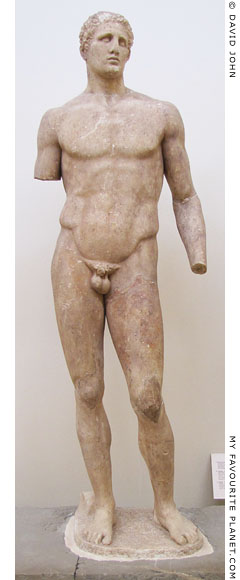
The marble statue of Hagias
of Pharsalos in Delphi.
Delphi Archaeological Museum.
Inv. No. 1875. |
| |
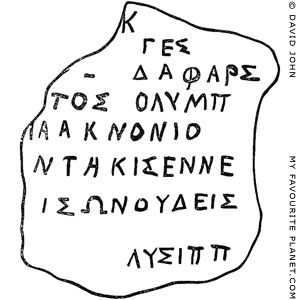
A drawing of Stackelberg's copy of
Lysippos' signature on a fragment of a
statue base from Pharsalos, Thessaly.
Source: Erich Preuner, Ein delphisches
Weihgeschenk. Fig. A, page 18. Bonn, 1899. |
| |
| |
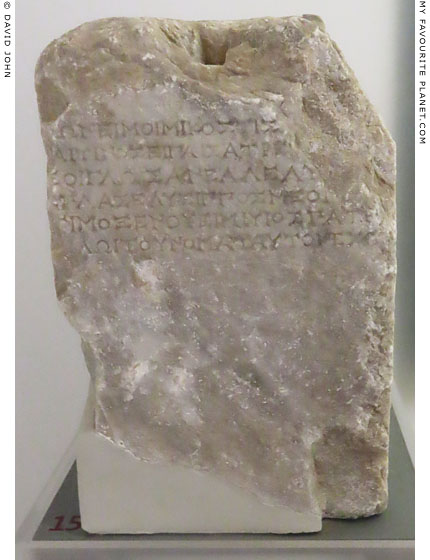
Part of the inscribed base of a votive statue of a child named
Timoxenos, son of Timoxenos, by Lysippos the Younger,
possibly a descendant of the famous Lysippos of Sikyon.
Last quarter of the 3rd century BC.
Found in the Asklepieion on Kos, Dodecanese, Greece.
Asklepieion archaeological site, Kos. Inv. Nos. E539 and E577.
Inscription IG XII 4,2,972. |
| |
Lysistratos of Sikyon
Λυσίστρατος Σικυώνιος
Working circa 328-325 BC
Brother of Lysippos, from Sikyon, northeastern Peloponnese.
According to Pliny the Elder, Lysistratos was the first to make moulds of faces from plaster masks, to make plaster casts of sculptures, and make realistic rather than idealized portraits:
"The first person who expressed the human features by fitting a mould of plaster upon the face, and then improving it by pouring melted wax into the cast, was Lysistratus of Sicyon, brother of Lysippus, already mentioned. It was he, in fact, who first made it his study to give a faithful likeness; for before his time, artists only thought how to make their portraits as handsome as possible.
The same artist, too, was the first who thought of making models for his statues; a method which afterwards became so universally adopted, that there could be neither figure nor statue made without its model in clay. Hence it would appear, that the art of modelling in clay is more ancient than that of moulding in bronze."
Pliny the Elder, Natural History, Book 35, chapter 44. |
|
|
| |
Lysos
Λῦσος
From Macedonia
Pausanias wrote that Lysos made a statue at Olympia of Kriannios of Elis, who won a victory in the race in armour (Pausanias, Description of Greece, Book 6, chapter 17). |
|
|
| |
| Sculptors |
M |
|
 |
|
| |
Melas of Chios
Μελάς
From the eastern Aegean island of Chios, Late 7th - early 6th century BC
A member, perhaps the first, of a family of sculptors from Chios. He was the father of Mikkiades, grandfather of Archermos of Chios, great-grandfather of Bupalus and Athenis.
Pliny the Elder dated Melas earlier than Dipoenos and Skyllis (early 6th century BC), "the first artists who distinguished themselves in the sculpture of marble".
"Before these artists [Dipoenos and Skyllis] were in existence, there had already appeared Melas, a sculptor of the isle of Chios; and, in succession to him, his son Micciades, and his grandson Archermus; whose sons, Bupalus and Athenis, afterwards attained the highest eminence in the art. These last were contemporaries of the poet Hipponax, who, it is well known, lived in the sixtieth Olympiad."
Pliny, Natural History, Book 36, chapter 4. |
|
|
| |
Menas of Pergamon
Μενάς Περγαμηνὸς
Mid 3rd century BC
A marble statue base with the inscribed signature Μηνᾶς Αἴαντος Περγαμηνὸς ἐποίησεν (Menas Aiantos Pergamenos epoisen, Menas son of Aias of Pergamon made it) was found along with an over life-size marble statue of Alexander the Great, dated to the mid 3rd century BC, at Magnesia ad Sipylum, Lydia (Manisa, Turkey) in 1895. Istanbul Archaeological Museum. Statue Inv. No. 709. Cat. Mendel 536. Marble base with signature Inv. No. 744. Cat. Mendel 537. Inscription TAM V,2 1358. |
|
|
| |
Menekrates
Μενεκράτης (Latin, Menecrates), also referred to as Menekrates of Rhodes
Sculptor and perhaps architect. Perhaps from Rhodes, 2nd century BC.
Menekrates was mentioned by Pliny the Elder as the teacher or adoptive father of the sculptors Apollonius and Tauriscus, sons of Artemidorus (Ἀρτεμίδωρος). The brothers' marble statue group of Dirce and the Bull, taken from Rhodes to Rome, is listed among several artworks displayed in the buildings of Gaius Asinius Pollio (75 BC - 4 AD):
"... Hermerotes, by Tauriscus, not the chaser in silver, already mentioned, but a native of Tralles; a Jupiter Hospitalis by Papylus, a pupil of Praxiteles; Zethus and Amphion, with Dirce, the Bull, and the halter, all sculptured from a single block of marble, the work of Apollonius and Tauriscus, and brought to Rome from Rhodes. These two artists made it a sort of rivalry as to their parentage, for they declared that, although Artemidorus was their natural progenitor, Menecrates would appear to have been their father."
Pliny the Elder, Natural History, Book 36, chapter 4. At Perseus Digital Library.
(The Perseus translation has "Apollodorus" for the name of the father, but the Latin text and other translations have "Artemidorus".)
As is often the case with Pliny, it is not clear if the Tauriscus, "a native of Tralles" (Tralleis, Τράλλεις, Caria) mentioned earlier is the same person as the brother of Apollonius. Some scholars, believing them to be the same, refer to the brothers as Apollonius and Tauriscus of Tralles.
It is thought that the much-restored marble statue group known as the "Farnese Bull" (Toro Farnese) may be a 3rd century AD copy of the "Zethus and Amphion, with Dirce, the Bull, and the halter" by Apollonius and Tauriscus, probably made in the late 2nd or early 1st century BC. See Apollonius and Tauriscus for further details.
In his poem Mosella, the Roman poet Decimius Magnus Ausonius (circa 310-395 AD) mentioned a Menecrates among a list of famous Greek architects and sculptors, probably taken from Marcus Terentius Varro's lost work Hebdomades vel de imaginibus (Groups of seven or on portraits, also known as Imagines). Unfortunately, we are not told which eye-catching work (or works) he made at Ephesus.
"... perchance here nourished the craft of renowned Menecrates, and that skill which draws all eyes at Ephesus..."
Ausonius, Mosella, § 298. At ToposText.
Read the full quote and more about Ausonius and Varro on the Deinokrates page (currently being rewritten).
It has been suggested that Menekrates was one of the sculptors who worked on the Great Altar of Zeus in Pergamon:
"Both Tauriskos and Apollonios were adopted by Menecrates, son of Menecrates, one of the artists of the Pergamon frieze."
Guy Dickens, Hellenistic sculpture, pages 48-49. Clarendon Press, Oxford, 1920. At the Internet Archive.
Unfortunately, no evidence or references are provided by Dickens or others who have repeated this claim. It is not known who designed the altar or made the friezes and other sculptures for it, and these questions have long been subjects of debate and speculation. Parts of inscribed signatures of artists have been found on fragments of marble blocks from the Gigantomachy frieze, including that of Μενεκράτης Μενεκράτους (Menekrates, son of Menecrates, IvP 70), but it is not known if this was the person mentioned by Pliny.
See: Max Fränkel (editor), Altertümer von Pergamon, Band VIII, Die Inschriften von Pergamon, I: Bis zum Ende der Königszeit (IvP), No. 70, page 57. W. Spemann, Berlin, 1890. At Heidelberg University Digital Library. |
|
|
| |
Menestratos (of Athens)
Μενέστρατος
Dates and places unknown, perhaps from Athens, 4th century BC
"At Rome... A Hercules, too, by Menestratus, is greatly admired; and there is a Hecate of his at Ephesus, in the Temple of Diana [Artemis] there, behind the sanctuary. The keepers of the temple recommend persons, when viewing it, to be careful of their eyes, so remarkably radiant is the marble."
Pliny the Elder, Natural History, Book 36, chapter 4.
The 2nd century AD Syrian Christian theologian Tatian (Τατιανός; Latin, Tatianus; circa 120-180 AD) mentioned a statue by a sculptor named Menestratos of the poetess Learchis (otherwise unknown) among sculptures by renowned Greek artists which had been taken to Rome:
"For Lysippus cast a statue of Praxilla, whose poems contain nothing useful, and Menestratus one of Learchis, and Selanion one of Sappho the courtesan, and Naucydes one of Erinna the Lesbian, and Boiscus one of Myrtis, and Cephisodotus one of Myro of Byzantium, and Gomphus one of Praxigoris, and Amphistratus one of Clito.
But what should I say about Anyte, Telesilla, and Mystis? The first is by Euthykrates and Kephisodotos, the second by Nikeratos, the third by Aristodotos. Euthykrates made for you the Mnesarchis of Ephesos, Silanion the Korinna, Euthykrates the Argive Thalarchis, [. . . missing text . . .] Praxiteles and Herodotos the hetaira Phryne, and Euthykrates cast the Panteuchis made pregnant by a seducer. I set all this forth not having learned it from another, but [as a result of my trip to Rome where I saw the statues seized from you Greeks]."
Address to the Greeks (Oratio ad Graecos), chapter 33 (section 502). At Early Christian Writings.
A limestone base of a bronze statue of the hero Ptoios (Πτώϊον) inscribed with the signature of Menestratos of Athens (see below) was found along with other inscribed blocks in 1898 at the church of Agios Georgios, Akraifnio (Ακραίφνιο; before 1933 known as Karditsa, Καρδίτσα), the location of the ancient city of Akraiphia (Ἀκραιφία), Boeotia, central Greece. The inscription has been dated to the 4th century BC, and it is thought that the sculptor may have been the Menestratos referred to by Pliny and Tatian. The theory is perhaps supported by the fact that all the other known artists in Tatian's list, including Lysippos, Silanion, Naukydes, Kephisodotos (probably Kephisodotos the Younger) and Amphistratos, were also working in the 4th century BC.
The French archaeologist Paul Perdrizet (1870-1938), who was sent to Akraiphia by the French Archaeological School at Athens (l’École française d’archéologie d’Athènes) to investigate the inscriptions and first published them, suggested that the statue may have been taken to Rome (see links to his articles below). Indentations on the top of the base show that it had supported two separate statues of standing figures, and the second is thought to have been set up to replace Menestratos's statue during the Roman Imperial period. |
|
|
| |

A drawing of the front of the limestone base of a bronze statue of
the hero Ptoios, inscribed with a dedication by the city of Akraiphia
and the signature of the sculptor Menestratos of Athens.
4th century BC. Found in 1898 at Akraiphia (Ἀκραιφία),
Boeotia. Height 38 cm, width 106 cm, depth 77 cm.
Ἀκρηφιεῖε[ς Εἴ]ρωι Πτωίοι. Ἀρξάντων Εὐμάριος
Καφισοδωρίω, Ὀλυμπίωνος Λυσ[ι]νίω, Μελίτωνος
Ὁμολωιχίω, Καφισοδώρω Πτωιοδωρίω,
Ἀθανοδώρω Δαμαγαθίω.
Μενέστατος Άθηναῖος ἐπόησε.
The Akraiphians to the hero Ptoios. Under the direction of Eumaron
son of Kaphisodoros, Olympion son of Lysinos, Meliton
son of Omoloichos, Kaphisodoros son of Ptoiodoros,
Athanodoros son of Damagathos.
Menestratos of Athens made it.
Thebes Archaeological Museum. Inv. No. 648.
|
Source: Paul Perdrizet, Inscriptions d'Acraephiae, Bulletin de Correspondance Hellénique, Année 1898, 22, pages 241-260 (drawing on page 143). At Persée.
See also:
Paul Perdrizet, Inscriptions d'Acraephiae, Bulletin de Correspondance Hellénique, Année 1900, 24, page 70-81 (particularly pages 80-81) At Persée.
"Acraephiae - Inscriptions", (Archaeological News, September - December 1898), in American Journal of Archaeology, Volume 3 (second series), page 255. Archaeological Institute of America, 1899. At the Internet Archive.
"Acraephiae - Inscriptions", (Archaeological News, January - June 1901), in American Journal of Archaeology, Volume 5 (second series), pages 337-338. Archaeological Institute of America, 1901. At the Internet Archive.
Francesca Giovagnorio, Dedications for the Hero Ptoios in Akraiphia, Boeotia, Rosetta Journal, Issue 22, Spring 2018, pages 18-39. PDF at the Department of Classics, Ancient History and Archaeology, University of Birmingham, UK. |
|
|
| |
Menestratos of Pergamon
Μενέστρατος Ἱππίου Περγαμηνὸς (Menestratos, son of Hippias of Pergamon)
Late Hellenistic period
A group of six Late Hellenistic marble portrait statues were found 2004-2006 by Turkish archaeologists at the Bouleuterion of Aigai (Αἰγαί), Aeolia, western Anatolia (35 km south of Pergamon). Among them were two lifesize standing statues of men, now headless, wearing himations. Both figures are supported by tree trunks inscribed with the signature of the sculptor:
Μενέστρατος Ἱππίου Περγαμηνὸς ἐποίει
Menestratos, son of Hippias of Pergamon
Inscription SEG 58 1368
The statues, thought to have been made in the workshop of Menestratos in Pergamon before being taken to Aigai, are now in the excavation depot of the Manisa Archaeological Museum. Inv. Nos. A04.Pl.3 and A04.Pl.4.
See: Yusuf Sezgin and Serdar Aybek, A group of portrait statues from the Bouleuterion of Aigia: A preliminary report, pages 32-35. At academia.edu.
Menestratos and Hippias (Ἱππίας) were both common names in the ancient Greek world, and the authors point out that they are two of the most commonly used names in Pergamon during the 2nd and 1st centuries BC. |
|
|
| |
Mikon the Elder of Athens
Μίκων (Latin, Micon)
Painter and sculptor from Athens, mid 5th century BC.
Son of Phanochos, and a contemporary of Polygnotos of Thasos
Named "the Elder" to distinguish him from another painter named "the Younger".
For further details see Mikon the Elder of Athens under painters, including a statue of Kallias by the "Athenian painter Mikon", mentioned by Pausanias, the signed base of which has been found at Olympia. |
|
|
| |
Mikon of Syracuse
Μίκων
Early 3rd century BC
Son of Nikeratos (Νικήρατος) of Syracuse
Pausanias mentioned two statues of the Greek Sicilian Tyrant of Syracuse Hiero II (Ἱέρων Β΄, circa 308-215 BC) at Olympia by "Mikon, son of Nikeratos of Syracuse" (Μίκων Νικηράτου Συρακούσιος):
"The statues of Hiero at Olympia, one on horseback and the other on foot, were dedicated by the sons of Hiero, the artist being Micon, a Syracusan, the son of Niceratus."
Pausanias, Description of Greece, Book 6, chapter 12, section 4.
Since the statues were dedicated by Hiero's sons, it is thought that they were made shortly after his death in 215 BC.
Mikon of Syracuse may have been the sculptor of bronze statues of athletes referred to by Pliny the Elder:
"Micon is admired for his athletes."
Pliny, Natural History, Book 34, chapter 19.
However, the Athenian painter and sculptor Mikon the Elder of Athens is also known to have made at least one statue of an athlete. |
|
|
| |
Mnesikles
Μνησικλής
Sculptor and architect working in Athens, 5th century BC
According to Plutarch, Mnesikles designed the Propylaia of the Athens Acropolis, and he may have also been the architect of the Erechtheion.
Plutarch, Parallel Lives, Pericles, 13.7-8.
Nothing is known of his life or other work. |
|
|
| |
Myron
Μύρων (Myron of Eleutherai)
Mid 5th century BC, working circa 480-440 BC
He was an Athenian citizen, born in Eleutherai (Ἐλευθεραί), on the border between Attica and Boeotia.
Like Pheidias and Polykleitos the Elder, he may have been a pupil of Ageladas of Argos, and was working during the 90th Olympiad (420-417 BC), as a contemporary of Polykleitos, Phradmon, Pythagoras, Skopas, and Perellus. (Pliny the Elder, Natural History, Book 34, chapter 19).
He was the father and/or teacher of Lykios (father, according to Pausanias, Description of Greece, Book 1, chapter 23, section 7, and Book 5, chapter 22, section 3; teacher, according to Pliny the Elder, Natural History, Book 34, chapter 19).
Pliny also wrote that while Myron used bronze from Delos, Polykleitos used bronze from Aegina. "They were contemporaries and fellow-pupils, but there was great rivalry between them as to their materials." (Natural History, Book 34, chapters 5-6.)
Pausanias mentioned a number of statues of victorious athletes by Myron at Olympia:
"Xenarces [a horse-breeder from Sparta] succeeded in winning other victories, at Delphi, at Argos and at Corinth. Lycinus brought foals to Olympia, and when one of them was disqualified, entered his foals for the race for full-grown horses, winning with them. He also dedicated two statues at Olympia, works of Myron the Athenian."
Pausanias, Description of Greece, Book 6, chapter 2, section 2. At Perseus Digital Library.
The notes by the translators of this edition, W. H. S. Jones and H. A. Ormerod, state: "Myron flourished about 460 B.C., and the race for foals was not introduced till 384 B.C. Hence, either the Greek text must be emended, or some other Myron, and not the earlier sculptor of that name, must be referred to here."
"The statue of Timanthes of Cleonae, who won the crown in the pancratium for men, was made by Myron of Athens..."
Book 6, chapter 8, section 4.
"After Baucis are statues of Arcadian athletes: Euthymenes from Maenalus itself, who won the men's and previously the boys' wrestling-match; Philip, an Azanian from Pellana, who beat the boys at boxing, and Critodamus from Cleitor, who like Philip was proclaimed victor in the boys' boxing match. The statue of Euthymenes for his victory over the boys was made by Alypus; the statue of Damocritus was made by Cleon, and that of Philip the Azanian by Myron."
Book 6, chapter 8, section 5.
"There is also set up in Olympia a slab recording the victories of Chionis the Lacedaemonian. They show simplicity who have supposed that Chionis himself dedicated the slab, and not the Lacedaemonian people. Let us assume that, as the slab says, the race in armour had not yet been introduced; how could Chionis know whether the Eleans would at some future time add it to the list of events? But those are simpler still who say that the statue standing by the slab is a portrait of Chionis, it being the work of the Athenian Myron."
Book 6, chapter 13, section 2. |
|
|
| |
On the Acropolis in Athens, Pausanias recorded a statue of Perseus after beheading Medusa by Myron as well as a bronze by his son Lykios.
"I remember looking at other things also on the Athenian Acropolis, a bronze boy holding the sprinkler, by Lycius son of Myron, and Myron's Perseus after beheading Medusa."
Pausanias, Description of Greece, Book 1, chapter 23, section 7. At Perseus Digital Library.
Soon after Pausanias mentioned two other statue groups, one of Athena and the Silen Marsyas (see photo, right and photos below), and the other of the Athenian hero Theseus fighting the Minotaur (see photos below), both of which have also been attributed to Myron.
"In this place is a statue of Athena striking Marsyas the Silenus for taking up the flutes that the goddess wished to be cast away for good. Opposite these I have mentioned is represented the fight which legend says Theseus fought with the so-called Bull of Minos, whether this was a man or a beast of the nature he is said to have been in the accepted story."
Pausanias, Description of Greece, Book 1, chapter 24, section 1.
He also noted that Myron made the cult statue of Hekate for the temple of the goddess in Aegina.
"Of the gods, the Aeginetans worship most Hecate, in whose honor every year they celebrate mystic rites which, they say, Orpheus the Thracian established among them. Within the enclosure is a temple; its wooden image is the work of Myron, and it has one face and one body. It was Alcamenes [Alkamenes], in my opinion, who first made three images of Hecate attached to one another, a figure called by the Athenians Epipurgidia [Ἐπιπυργιδία, on the Tower]; it stands beside the temple of the Wingless Victory [Temple of Athena Nike on the Athens Acropolis]."
Pausanias, Description of Greece, Book 2, chapter 30, section 2. At Perseus Digital Library.
On Mount Helikon (Ἑλικὼν ὀρῶν) in Boeotia stood a standing statue of Dionysus by Myron. It had been dedicated by the Roman general Sulla who had taken it from Orchomenos (Ὀρχομενός) in Boeotia.
"There is also on Helicon a bronze Apollo fighting with Hermes for the lyre. There is also a Dionysus by Lysippus; the standing image, however, of Dionysus, that Sulla dedicated, is the most noteworthy of the works of Myron after the Erectheus at Athens. What he dedicated was not his own; he took it away from the Minyae of Orchomenus. This is an illustration of the Greek proverb, 'to worship the gods with other people's incense.'"
Pausanias, Description of Greece, Book 9, chapter 30, section 1. At Perseus Digital Library.
|
|
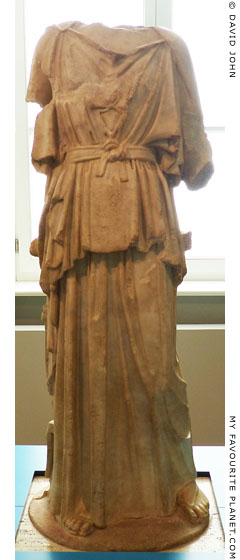
A marble statue of Athena thought
to be a Roman copy of the figure
from the statue group of Athena
and Marsyas, made by Myron
around 460-450 BC and set up
on the Athenian Acropolis.
(See also photos below.)
1st half of the 2nd century AD.
Carrera marble.
Museum für Kunst und Gewerbe
Hamburg. Inv. No. 1961.288 / St. 168.
Stiftung für die Hamburger
Kunstsammlung. |
|
Pliny the Elder devoted quite a bit of space to Myron and his works.
"Myron of Eleutherae, who was also the pupil of Agelades, was rendered more particularly famous by his statue of a heifer, celebrated in many well-known lines: so true is it, that most men owe their renown more to the genius of others, than to their own.
He also made the figure of a dog, a Discobolus, a Perseus, the Pristae [Sawyers], a Satyr [Marsyas] admiring a flute, and a Minerva, the Delphic Pentathletes, the Pancratiastae, and a Hercules, which is at the Circus Maximus, in the house of Pompeius Magnus.
Erinna, in her poems, makes allusion to a monument which he erected to a cricket and a locust. He also executed the Apollo, which, after being taken from the Ephesians by the Triumvir Antonius, was restored by the Emperor Augustus, he having been admonished to do so in a dream.
Myron appears to have been the first to give a varied development to the art, having made a greater number of designs than Polycletus, and shewn more attention to symmetry. And yet, though he was very accurate in the proportions of his figures, he has neglected to give expression; besides which, he has not treated the hair and the pubes with any greater attention than is observed in the rude figures of more ancient times."
Pliny, Natural History, Book 34, chapter 19.
"As to Myron, who is so highly praised for his works in bronze, there is by him at Smyrna, An Old Woman Intoxicated, a work that is held in high estimation."
Pliny, Natural History, Book 36, chapter 4.
His statue of a heifer was also mentioned by Ovid (De Ponto) and several epigrammatic poets. The Byzantine author Procopius (500 - circa 565 AD) reported that the staue was in Rome. There is no known surviving copy.
Several Roman period marble statues of a discus thrower are thought to be copies of the bronze Discobolus (Δισκοβόλος) made by Myron around 460-450 BC, mentioned by Pliny, Quintilian and Lucian.
"'Statue!' said I, 'what do you mean?'
'Have you not observed on coming in,' said he, 'a very fine statue set up in the hall, the work of Demetrius, the maker of portrait-statues?'
'Do you mean the discus-thrower,' said I, 'the one bent over in the position of the throw, with his head turned back toward the hand that holds the discus, with one leg slightly bent, looking as if he would spring up all at once with the cast?'
'Not that one,' said he, 'for that is one of Myron's works, the discus-thrower you speak of. Neither do I mean the one beside it, the one binding his head with the fillet [Diadumenos], the handsome lad, for that is Polycleitus' work. Never mind those to the right as you come in, among which stand the tyrant-slayers, modelled by Critius and Nesiotes [Harmodius and Aristogiton]...'"
Lucian of Samosata (circa 125-180 AD), The lover of lies (also known as The liar or The doubter; Greek, Φιλοψευδής ἢ Ἀπιστῶν; Latin, Philopseudes sive Incredulus), section 18. In: A. M. Harmon (translator), Lucian Volume 3 (of 8), pages 346-347. The Loeb Classical Library edition in Greek and English. Harvard University Press, Cambridge, Mass., and William Heinemann, London, 1960.
Surviving copies include:
The "Palombara Discobolus" or "Lancellotti Discobolus" (see photo below), the first example of the type to be discovered. Found in 1781 at the Villa Palombara on the Esquiline Hill, Rome. It was identified as a copy of Myron's statue from Lucian's description. The right arm and the left foot have been re-attached. The right calf, the fingers of the left hand, the oval base over the ancient plinth and perhaps the lower part of the discus are restorations. Height 155 cm (without the modern base). Palazzo Massimo alle Terme, National Museum of Rome. Inv. No. 126371.
Part of another Discobolus statue of the Lancellotti type (see photo below) was found in the so-called "Villa del Discobolo", Villa Reale, Castel Porziano (ancient Porcigliano), Rome, in 1906. The head, right arm, fingers of the left hand and lower legs are missing. Restored from fourteen fragments, with the addition of parts in plaster: on the left thigh, the palm-trunk support and the base. Parian marble. Height 148 cm (with the base). Palazzo Massimo alle Terme, National Museum of Rome, Inv. No. 56039.
The "Townley Discobolus" (see photo below). Found in 1791 at Hadrian's Villa, Tivoli, near Rome. British Museum, London. Height 169 cm. Inv. No. 1805,0703.43 (Sculpture 250). Acquired from the Townley Collection in 1805.
Another marble Discobolos found around the same time at Hadrian's Villa in Tivoli is now in the Museo Pio-Clementino, Vatican Museums, Rome. Inv. No. 2349.
A torso of Carrara marble thought to be of a Discobolus statue, found in Rome in the early 18th century, was restored by the French sculptor Pierre-Étienne Monnot (1658-1733) as a wounded warrior. Palazzo Nuovo, Capitoline Museums, Rome. Inv. No. MC0241. Donated by Pope Clement XII.
Myron's bronze statue group of Athena and the satyr Marsyas was set up on the Athens Acropolis around 460-450 BC.
A marble statue of a nude Zeus from the Nymphaeum of Herodes Atticus in Olympia is thought to be a copy of a work of Myron, made around 460 BC. Olympia Archaeological Museum. Inv. No. Λ 109. See photo on the Herodes Atticus page.
Martial (6.92, 8.51) mentioned cups, probably of chased silver, made by Myron. |
|
|
| |
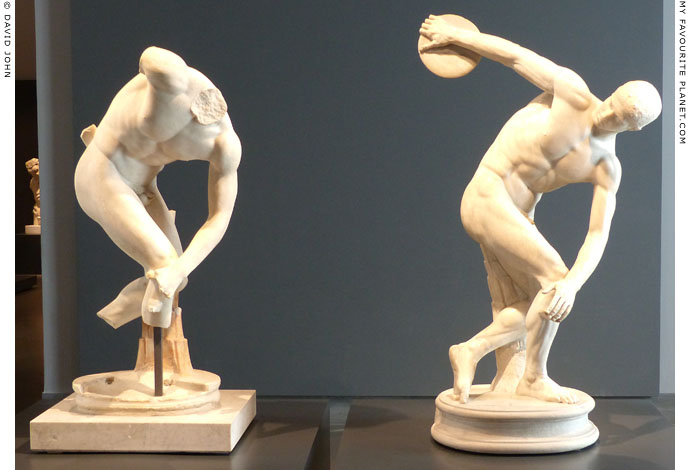
The two Discobolus statues of the Lancellotti type exhibited side by side in the
Palazzo Massimo alle Terme, National Museum of Rome. The "Palombara Discobolus"
or "Lancellotti Discobolus" (Inv. No. 126371) is on the right. Height 155 cm. |
| |
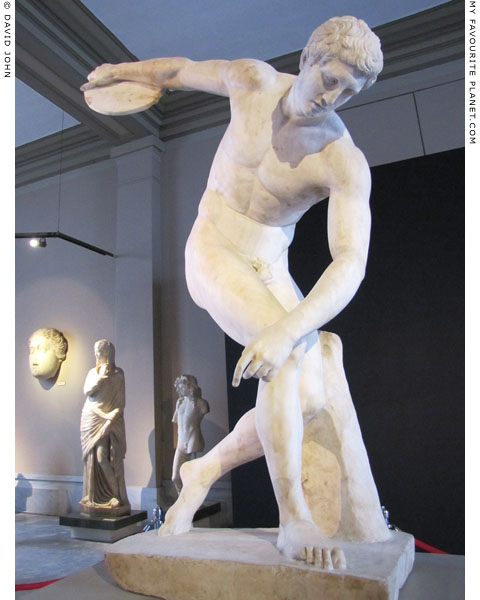
The "Townley Discobolus", marble statue of a discus thrower.
2nd century AD, Roman period. Thought to be a copy of the
bronze Diskobolos (Δισκοβόλος) by Myron, around 460-450 BC.
Found in 1791 at Hadrian's Villa, Tivoli, near Rome. Height 169 cm,
width 105 cm, depth 63 cm.
British Museum, London. Inv. No. 1805,0703.43 (Sculpture 250).
Acquired from the Townley Collection in 1805.
(Exhibited in the Istanbul Archaeological Museum in 2010.)
|
The statue was found headless, and when it was restored in Rome an ancient but non-related head was added. It was purchased at public auction in Rome in 1792 by the English antiquarian and art dealer Thomas Jenkins (1724-1798), who sold it to the English collector Charles Townley (1737-1805) for £400. After it was placed in Townley's gallery in London in 1794, Richard Payne Knight noticed that the head had been incorrectly restored to face forwards rather than back (as on the "Palombara Discobolus").
See also a marble right hand holding a discus found in the Vedius Gymnasium, Ephesus. |
|
|
| |
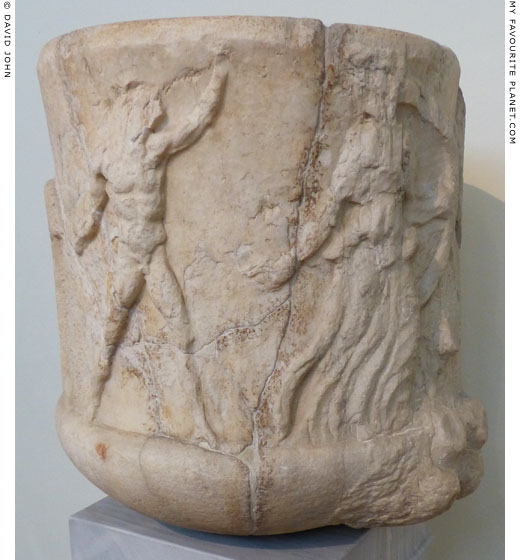
An unfinshed marble krater with a relief of Silen Marsyas (left), nude and
with raised left arm, discovering the flute (or flutes probably the double
aulos pipes) just thrown away by Athena with her lowered right hand as
she walks away to the right, The goddess wears a crested helmet and
peplos, and carries a round shield in her left hand. The composition is
believed to reproduce the statue group of Athena and Marsyas, sculpted
by Myron around 460-450 BC, which stood on the Acropolis in Athens.
It should be noted that although Pliny mentioned "a Satyr admiring a flute,
and a Minerva" by Myron, Pausanias wrote of "a statue of Athena striking
Marsyas", (see quotes above) which is not what is depicted on this relief
or other similar artworks such as the vase below.
Work of a Neo-Attic workshop, mid 1st century BC. Pentelic marble.
Found in Athens. Known as the "Finley crater" after the British
historian to whose collection it once belonged.
National Archaeological Museum, Athens. Inv. No. 127. |
| |
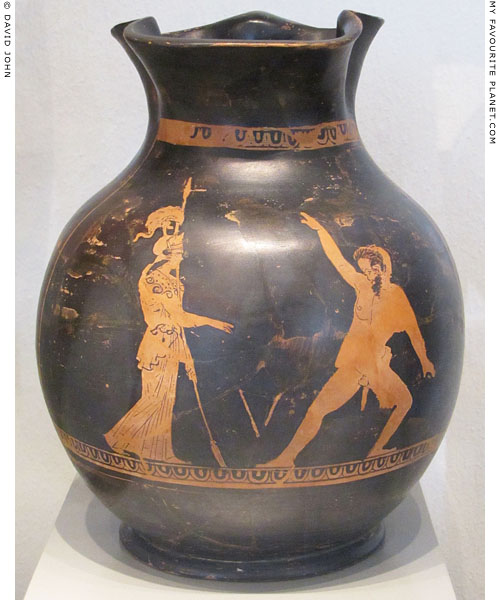
Vase painting of Marsyas finding Athena's flute on the side of an Attic
red-figure trefoil oinochoe (οἰνοχόη, wine jug). The composition is
similar to the relief on the krater above. but the vase painter has made
some alterations. Although Marsyas is standing in the same exaggerated
pose, with one arm raised, the figure has been mirrored, and he now
stands on the right. Athena, here on the left, faces him as she drops the
pipes on the floor. As in the relief she wears an Attic helmet and peplos,
as well as the aegis, but here she carries a spear rather than a shield.
450-425 BC. Attributed to the Codrus Painter.
Found in Vari (Βάρη), Attica, Greece.
Altes Museum, Berlin. Inv. No. F 2418. Acquired in 1872. |
| |
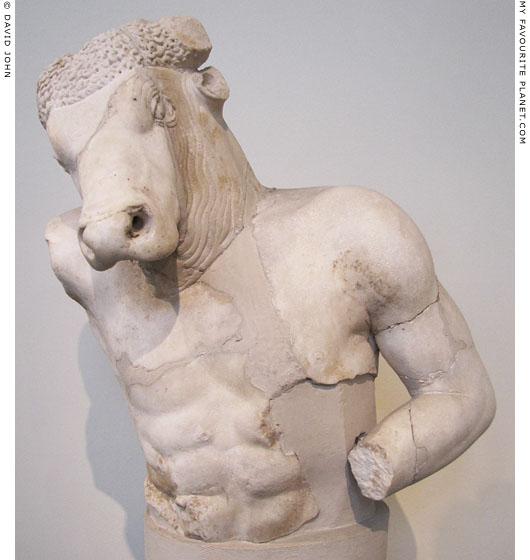
Restored fragments of a marble statue of the Minotaur, thought to be part
of a Roman period copy of a sculpture group attributed to Myron depicting
the mythological fight between Theseus and the Minotaur in the labyrinth
of King Minos on Crete. The original group is thought to have been erected
on the Athenian Acropolis in the mid 5th century BC. The copy is thought to
have been set up in a fountain, since a deep hole pierced in the Minotaur's
mouth indicates that it was used as a water spout.
Pentelic marble. Height 73 cm.
The head and torso as well as a marble torso believed to be from the
statue of Theseus (see below) were found near Agios Demetrios
Katephoris Church in the Plaka, central Athens.
National Archaeological Museum, Athens. Inv. No. 1664a. |
| |
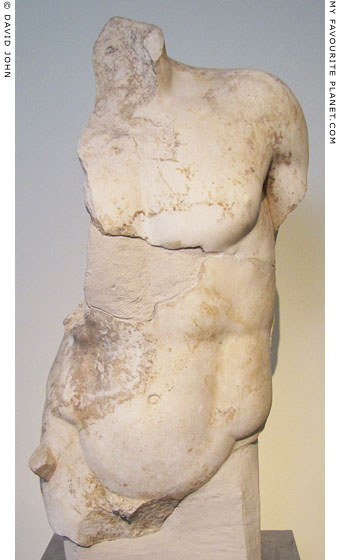
The fragmentary marble torso thought to be part of the
statue of Theseus from the Roman period copy of a sculpture
group of Theseus and the Minotaur by Myron (see above).
Pentelic marble. Height 82 cm.
National Archaeological Museum, Athens. Inv. No. 1664. |
| |
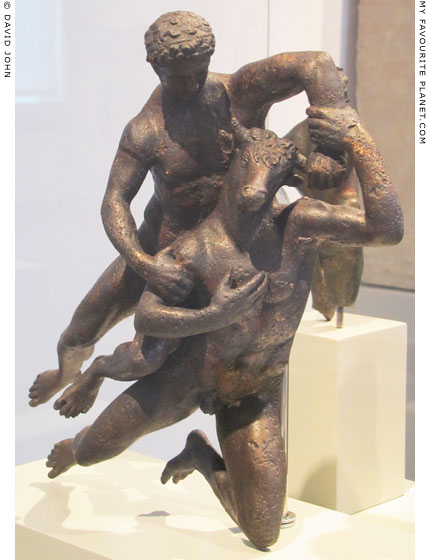
Bronze statuette of Theseus fighting the Minotaur.
Hellenistic period, 3rd - 1st century BC. Found in 1878
in the Maeander valley, near Aphrodisias, western Turkey.
Altes Museum, Berlin. Inv. No. Misc. 7382.
|
Both figures have muscular naked bodies. The statuette is displayed so that its weight appears to be supported by the Minotaur's left knee, onto which it has fallen, and the tip of the big toe of its right foot, the right leg being extended behind it. The work is actually supported by a modern metal stand. Theseus thus appears to be riding side-saddle on the Minotaur's back, using his body weight to push down on its left horn with his left hand. With his right hand he has a strong grip on the beast's right shoulder. He has short, wavy hair and wears a fillet (thin headband). The Minotaur grasps Theseus' left wrist with its left hand, and holds its right hand to its chest, perhaps covering a wound.
As with many mythological themes in Greek art, recognizable depictions of Theseus and the Minotaur began appearing from the 7th century BC, for example on gold foil relief jewellery from Corinth, around 675-650 BC. Altes Museum, Berlin. Inv. No. GI 333. A large number of Athenian vases, particularly black figure vessels, made from around 550 BC, have survived as well as works in other media such as reliefs (e.g. a metope from the Athenian Treasury, Delphi), terracottas, coins and mosaics.
A number of different types have been discerned in representations of the fight. Many show just the two combatants, sometimes wrestling, others with Theseus killing the Minotaur with a sword. Some depictions include other figures as onlookers, including Ariadne, gods or Theseus' fellow young Athenian hostages. On a few occasions, particularly on Roman period mocaics, the labyrinth itself is indicated, and even the bones of the Minotaur's previous victims.
It has been suggested that the composition of the Minotaur statue group on the Athenian Acropolis may be reflected in Athenian vase paintings of the mid 5th century BC. |
|
|
| Photos and articles © David John, except where otherwise specified. |
 |
Visit the My Favourite Planet Group on Facebook.
Join the group, write a message or comment,
post photos and videos, start a discussion... |
|
|
| |
|
|
| |
| |
 |
| |
 |
| |
 |
| |
 |
| |
 |
| |
 |
| |
George Alvanos
rooms in
Kavala's historic Panagia District
Anthemiou 35,
Kavala, Greece
kavalarooms.gr
|
| |
Olive Garden Restaurant
Kastellorizo,
Greece
+30 22460 49 109
kastellorizo.de
|
| |
Papoutsis
Travel Agency
Kastellorizo,
Greece
+30 22460 49 286
greeklodgings.gr
|
| |
|